Chiang Mai has at least 16 different wats or temples, all built by or for some royalty in the history of Thailand (which has also been called Siam). In all of these temples are various symbols mostly originally from Buddhism or stories about Buddhism, and also to some extent Hinduism. The distance from Chiang Mai to Kolkata is just a bit over 700 miles, about the same distance from Detroit to Boston, or San Francisco to Tucson. So it’s not too surprising that the strong Hindu culture has had influence here too.
During my meditation retreat at Doi Suthep, I had a chance to wander among the dozens of statues and icons that filled that wat. Buddhas of many forms, expressions, colors, even materials. And within that variety were many different positions and hand gestures. When you encounter something new, all the variety blends together into a kind of mush –“oh look, another gold Buddha!” Being the curious guy I am, wanted to know more. Surely there was SOME reason why one Buddha was standing with his hands up palms facing out, and the next Buddha was sitting with his hands folded in his lap. And so the purpose of this blog entry is to tell you what I learned. All of this material is on the web in much more learned and undoubtedly accurate form. But this is MY journey, so all the explanations and pictures are mine.
In the previous post, I offered up a short intro to Buddhism. Most of the Buddha iconography was created to illustrate some aspect of The Four Noble Truths for followers; most aim to help followers follow the Middle Path. They also have a significance related to an important event in the life – or past lives – of the Historical Buddha.
First we’ll look at the four major body positions found in Thailand, and then we’ll dig into some of the gestures, or mudras, that I found.
The Buddha is presented in 4 positions (not related to the 4 Truths).
The Buddha is shown sitting whenever he is meditating or teaching the Dharma, which is the Buddhist understanding of the Nature of Life.
According to the stories, upon attaining enlightenment, the Buddha stood under the Banyan tree for 7 days, contemplating the suffering of all beings. Often, standing Buddhas reflect this time in his life.
(Aside: I got confused about the difference between the Banyan Tree and the Bodhi Tree, both peppered around Buddhist stories. Here’s what I found out, but please tell me where I’m wrong. The historical Buddha sat under the Bodhi Tree (Ficus religiosa) when he attained enlightenment (the word “Bodhi” means “enlightenment), and then he stood for 7 days under the Banyan Tree (Ficus urostigma) to contemplate the suffering of all beings with this newfound enlightenment. (more)
The reclining Buddha depicts the Buddha in his last few moments on earth, before dying and entering Nirvana. If he is using his hand to hold up his head, then he is merely resting, moments before dying. If his head is laying on the ground, then he is dying or gone.
When the Buddha statue is walking, it represents a time when the Buddha was returning to earth after delivering a sermon on the Dharma in Heaven. This position is shown with the Buddha standing with the right foot behind the left, starting to raise off the ground. We were taught this way of walking in my retreat.
Within each position, the Buddha is shown holding his hands in certain ways or gestures (called mudras in Sanskrit for “token” or “sign”). There are many, many mudras across the Buddhist world (see here), but I’ll just focus on the ones I actually saw here in Thailand. These are:
| Sanskrit Name | Meaning |
| Abhaya | Gesture of Imparting Fearlessness & Protection |
| Anjali | Gesture of Greeting and Adoration |
| Bhumisparsha | Gesture of Touching Earth – Enlightenment |
| Dhyana | Gesture of Meditation |
| Karana | Gesture of Warding off Evil |
| Vajrapradama | Gesture of Unshakable Self Confidence |
| Varada | Gesture of Compassion and Granting Wishes |
| Vitarka | Gesture of Teaching |
Abhaya Gesture of Imparting Fearlessness, Protection, and Reassurance
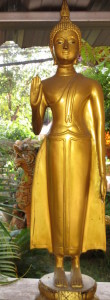 |
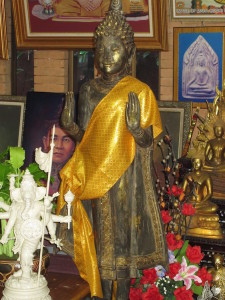 Double Abhaya |
Description:
Right hand up at chest level, palm facing forward. Sometimes the left hand resting on left thigh, in the lap, palm facing up, and sometimes the left hand is also at chest level, palm facing forward. Mostly I’ve seen both palms facing forward in Standing Buddhas, and one palm facing forward in Sitting Buddhas (which sort of makes sense since a sitting Buddha has a lap to place the left hand.)
Meaning:
Gesture of Imparting Fearlessness and Reassurance.
The idea is that the open palm shows a hand empty of weapons, and therefore is the sign of friendship and peace. It also looks like a “stop” signal to an enemy (as my guide in Cambodia explained). So in both interpretations, it means fearlessness.
According to tradition, the Buddha made this gesture immediately after gaining enlightenment. And later, when he was about to be attacked by an angry elephant, he held up his hand in the fearlessness gesture and immediately calmed it. So if you’re ever attacked by an angry elephant, you know what to do! (more)
Anjali Gesture of Greeting and Adoration (also known as Namaskara or Namaste)
Description:
Palms together at forehead or heart. Why? Because only with the heart, or with a deeper spiritual insight (third eye, which is at the forehead) can one truly see that we are all expressions of the same Divine force.
Meaning:
Gesture of Greeting and Adoration
Anjali means “double handful”(cite), and translates from Sanskrit to “offerings” (cite). The gesture is offered as a greeting of great respect for the Divine in all. Using two hands in Anjali expresses the co-existence of two worlds that form a duality: the spiritual and the material world, as well as the static and dynamic nature of things.
A note: Because this is a gesture of homage, you never see a statue of Buddha doing it, only followers who have attained enlightenment (called bodhisattvas). This is because the Buddha IS the one with all the power and light and divinity. One doesn’t show homage to oneself, now does one? (Well…)
Interestingly, the Thai people today use the Anjali when they express wai, which is a greeting to almost everyone. Where Westerners might shake hands in greeting, Thais do wai instead. Thais do wai everywhere; the counter clerk even shows me wai (the Anjali gesture), after I buy a bag of popcorn at the movies, and my golf caddy, aptly named Pin, does wai for me at the end of my round when I tip her (of course, given her excessively optimistic scoring of my game, I should be expressing my high respect and adoration for her).
Bhumisparsa Gesture of Enlightenment
Description:
Right hand is palm down, bent over the right knee. And ideally the fingers are touching the ground (earth). The left hand lies in the lap, palm facing up.
Meaning:
Gesture of Touching Earth, Gesture of Enlightenment
Bhumisparsa was reported to be the gesture the Buddha showed the moment he attained enlightenment, and so for contemporary Buddhists, symbolizes the hope for their own enlightenment. (If I get that far, I imagine mine will be a self smack across the forehead. Doh!) This gesture expresses the strength and truth of his commitment to enlightenment, which helped him overcome all the temptations and darkness (Mara) that came to him right before enlightenment.
“During meditation, Siddhartha is subjected to many temptations, many posed by the evil Mara, who bombards him with his demons, monsters, violent storms as well as his three seductive daughters. The Buddha remains steadfast! Then, to testify to Mara of his meritorious past, he points to the earth with his hand and calls the Earth Goddess, Thorani. She rises from the ground and wrings the water from her long black hair, by this action raising a torrential flood that drowns Mara and his army of demons.“ From here.
Note: Before the historical man became known as the Buddha, he was a Northern Indian prince named Siddhartha Gautama. Herman Hesse’s novel “Siddhartha” which I really enjoyed is, I think, one accessible account of how the Buddha came to be.
By all accounts, and my own experience, Bhumisparsa is easily the most common Buddha gesture in Thai wats.
Dhyana Gesture of Meditation (Also known as Samadhi )
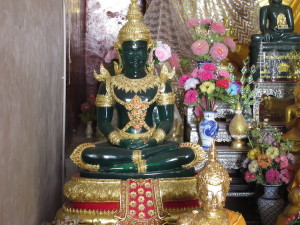
An “Emerald” Buddha, replicating the original Emerald Buddha which sits in Bangkok. The original was created in, some say, 40 BCE.
Description:
Both hands in lap, palms facing up. Right hand rests in left hand. Sometimes the thumbs touch, forming a triangle which is seen to be the circle of energy. Usually in a sitting Buddha.
Meaning:
Gesture of Meditation
This mudra signifies meditation and contemplation, one of the primary practices that Buddhists use to follow the Middle Path. The Bodhisattva makes a vow and is determined not the leave the spot (where he is sitting on the grass) until he achieves enlightenment. The Bodhisattva determines to find the cause of suffering and its cessation.
Sometimes the Dhyāna mudrā is used in certain representations of Bhaiṣajyaguru as the Medicine Buddha, with a medicine bowl placed on the hands.
For your meditation practice, you use this mudra inspire you to get deeper contemplation with higher energy.
Karana Gesture of Warding off Evil and Expelling Negativity
Description:
Right hand up and palm facing out, middle finger and ring finger crooked, middle finger touching thumb.
Meaning:
Gesture of Warding off Evil and Expelling Negativity
The karana mudra expresses a very powerful energy with which you can get rid of any negative energy you carry, like sickness, negative thoughts, anger, etc. If you sense evil coming your way, you can also use it to ward it off. Which is nice. More generally, the karana mudra is used to overcome any mental obstacles you have in your life. “You can sense a very determined, focused energy just by looking at this hand gesture.” As with other mudras, you can recite mantras slowly and intentionally. Here are two suggested mantras for Karana.
“May obstacles be removed.”
“May negative energy be thwarted.”
(I always have liked the word “thwart”)
Vajrapradama Gesture of Unshakable Self Confidence
Description:
Hands folded on chest, typically on standing Buddha.
Meaning:
Gesture of Unshakable Self Confidence
Vajrapradama expresses the kind of self confidence that doesn’t come from ego, or arrogance or even personal competence. It comes from the realization that we are at peace because we are at one with peace. This is the Buddhist idea that we are all connected, we are all part of Divine Life, and that we can draw self confidence from that realization, rather than from individual and personal achievement. So it’s confidence in the Self that is part of the Divine. Nice phrase I found: “When this confidence is there, the Heart becomes the strongest communicator.”
Varada Gesture of Compassion and Granting Wishes
Description:
Usually the left hand palm up of the left hand. . This mudra is made with the left hand, palm up and most often with other gestures, such as the Bhumisparsa or the Abhaya mudras.
Meaning:
Gesture of Compassion and Granting Wishes
Varada mudra expresses the energy of compassion, liberation and an offering of acceptance. It also is the mudra of the Buddha’s charity, and is the gesture of dispensing the kind of favors you’d want to get from an enlightened being (no, not winning lottery numbers).
The right hand is directed downward with palm open to the viewer, empty; fingers may be slightly bent as if to support a round object. If standing, the arm is slightly extended to the front. If seated, hand remains at breast level, a little to side, palm up, and often the other hand holds a corner of the kesa.
Varada represents offering, giving, welcome, charity, compassion and sincerity. It is the mudra of accomplishment of the wish to devote oneself to human salvation. The open hand and extended fingers symbolise the flowering of the Buddha’s Gift of Truth.
Varada is frequently seen combined with Abhaya mudra, where right hand makes the gesture of fearlessness, the left of wish granting. Standing Buddha figures often show abhaya and varada together.
Vitarka Gesture of Teaching
Description:
The hand is held closer to the chest than in the Abhaya mudra. The palm faces outward. The index finger and the thumb make a circle. The other three fingers point upward. Initially made with just the right hand, later on in history the gesture became often expressed with both hands.
Meaning:
Gesture of Teaching
Vitarka mudra evokes the energy of teaching and intellectual discussion, or argument. It mostly feels like the transmission of a particular teaching with no words, and the circle formed by the thumb and index finger creates a constant flow of energy/information. Close to Abhaya mudra , the energy created by this hand gesture allows for a transmission of knowledge in a protected way, without being impeded by fear.
And….that’s it for now. There are probably more mudras that I didn’t see, but because I didn’t see them, I’m not reporting on them.
There are also many different icons and assorted symbols in Thai wats, and my next post will cover them. Stay tuned for Ganesha, the Fat Buddha (who isn’t really a Buddha), Thorani, and more!
Can you add (or correct) anything you know about these mudras?
The next 3 posts will be about Buddhism.
Part 1 is a short intro to Buddhism off the top of my head, for those who know little about it, at least as I practice it.
Part 2 is a study of all the types of Buddha statues and iconography that I’ve found in scouring Northern Thailand temples: fascinating for me, and I hope you too!
Part 3 is a study of all the iconography I found in the temples that are NOT Buddha, which are fascinating in their own right.
In this first part, to illustrate how I “use” Buddhist principles, I also let you in on my very personal divorce recovery story.
Around the 5th century BCE an Indian prince named Siddartha Gautama became disenchanted with his privileged life in Northern India, reportedly after seeing someone dying. So he left his wealthy family and sumptuous, well-bubbled home, and began a quest to look for the answer. As you might imagine “stuff happened” which I won’t describe since it’s described so much in other places (see Herman Hesse’s book “Siddhartha” for a good fictional Western interpretation). One day, after much contemplation, Siddartha attained enlightenment and in that instant became the Buddha. The word “Buddha” means “awakened one” in Sanskrit. The Buddha’s teachings spread throughout India and then on to East Asia, getting assimilated in Japan alongside Shintoism, in China with Confucianism, and in SE Asia. Thailand, for example, is a deeply Buddhist country, even giving Buddhist monks special lines and sitting areas in airports. (More on the history of Buddha here.)
To understand my next two posts about the iconography of Thai Buddhism, it helps to understand a little bit about Buddhist principles, because the variance of the statues is due to the effort to express the different aspects and nuances of these principles, as well as the life of the historical Buddha. I won’t go too deep, but most forms of Buddhism start with the Four Noble Truths about life. The interpretations are all mine, and my learning of these is really just starting. And, as promised at the outset of this post, and at the risk of making some of you uncomfortable, I offer up a (formerly) painful personal example to make my experience with each Noble Truth more illustrative!
The Four Noble Truths (by Buddha)
Let’s look at these a bit more closely.
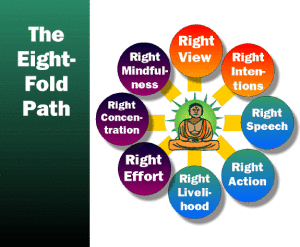
Those are the Four Noble Truths of Buddhism and most of the statues and depictions of Buddha have something to do with some aspect of them, most concerned with helping followers follow the Middle Path. They also have a significance related to an important event in the life – or past lives – of the Historical Buddha.
So I’ve told you all that to set up the next two posts about the iconography I found in Thai wats. Coming very soon!
Before we get there, though, if you have any corrections, clarifications, amplifications or thoughts of any kind to what I’ve written here, please add them in so I can learn more. Thank you!
Some of you may know, some may not, that I’ve adopted a Northern California version of Buddhism as my spiritual and philosophical orientation. It just makes the most sense to me. However, a huge chunk of the world, namely ASIA, approaches Buddhism much differently than the “whatever feels right to you” version I’ve been practicing. So one goal of this journey, while in Asia, was to learn how Asians practice Buddhism. And it’s different. The knowledge is the same, but the practice is much different. Here they worship Buddha in a somewhat similar way that Christians worship Jesus, or Muslims worship Allah. But more on that later. This is the story of my much-too-brief-yet-still-important 4 day retreat to an important Thai Buddhist Monastary. So let’s get started!
A Wat is a Buddhist temple, often with a monastery associated with it. For this adventure, I went to the Doi Suthep Wat, which is on Doi Suthep Mountain near Chiang Mai, Thailand. I discovered it while bemusedly searching online for such a Buddhist retreat center somewhere in Thailand. And it turned out to be in the city I was heading to. How…serendipitous. I originally wanted to do a 5 day visit, but they only had a free space for 3 nights (4 days). So, I took it!
From the Nimman district in Chiang Mai I took a taxi (well, a mini pick up truck with a people carrier on the back, open door, bench seating). Cost was 400 Baht ($12) for the ride up the mountain.
It was raining, which added some drama to the mad dash up the twisty turny mountain road, me sloshing around in the cargo section alone. But we arrived safely.
After eschewing the 309 step stairs up to the Wat proper, I took the funicular, found the office, and joined 2 other newbies, both women from Japan, one from Tokyo, the other from Fukuoka. The Intake Monk, nice guy from Bangkok, oriented us, and gave us some primer information including how to do 2 ways to meditating (walking and sitting) and how to do each.
Sitting. Cross legged, left leg under right leg, back straight, hands in front, palms up, left hand holding right hand. Eyes closed. Two styles. Breathing (“breathe in”, “breathe out”; or “rising”, “falling”) and Belly (hand on belly, “belly out”- on inhale, “belly in” – on exhale).
Intake Monk also taught us how to prostrate ourselves before the Buddha, hands clasped in front of face toward Buddha, sitting on knees, then lean forward and touch forehead to ground. Do this 3 times. (Everything is done in 3s). It is an act of reverence and submission to the Buddha, the Dharma and the Sangha.
Walking mediation. Mindfully focus on picking your foot up, moving it, putting it down. State, to yourself, your observation of what you are doing in THAT moment (“Standing”, “Standing”, “Standing”. “Intending to walk”, “Intending to walk”, “Intending to walk”, etc.) From the 5:30am Dharma talk, I learned there’s an important difference between saying “I am standing” and just “standing”. The latter is “better” because it puts you in the mind of observer, while the former puts you in the mind of actor. Important for later.
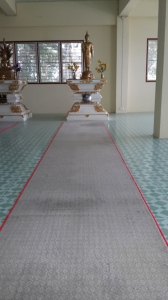
One of my walking meditation “paths” during my time at Doi Suthep. There are 7 of them in this room for others to use. All silently. Back and forth for 15 -25 minutes at a time.
Intake Monk then gave us the rules for the monastery. No alcohol, no killing, no lying, no eating after 11am lunch, wear white, keep talking to minimum (to let individuals have a chance to notice monkey mind). As a male monk, he has 206 rules. Women monks (nuns) have 326 rules (one version of these).
After he got us oriented, he took us HALFWAY to the next stop which was the office manager who would give us our room keys. This was a very sketchy path, involving slippery broken concrete, stepping along a skinny board placed over a large puddle, clambering over a rail system that I’m guessing they use to haul supplies up the steep hill. There were signs, but only directional. No identifying as in “you’re here!”, “Register here”. So my 2 accomplices and I navigated the best we could, stuck our head in an open door and I asked the guy in the back, behind a computer, if we were supposed to be here. He said, yes and so we ended up getting our keys. He then just pointed us down the hill and said “your rooms are down there”. Which we took to mean, “find them on your own”. 4 buildings, first two for women, second two for men. Fortunately, the room numbers were reasonably conceived: Room 201 was room 1 in Building 2. Mine was 410, the furthest away. It had been raining, a lot, and the old uneven concrete path was slippery – seems to be algae or moss on it.
Anyway, I almost got to my room but hit an especially dark slimy step and went down hard on my shin / knee. Tore my pants, skinned my shin pretty well, big swelling on my knee. There were no lights nor handrails on the stairs, so I started off my meditation weekend with some grumpy words about the Monastery staff and designers. In the US, this would have violated about a dozen safety rules. Anyway, I finally had a reason to open up my first aid kit and had everything I needed – antibacterial cream, gauze bandages, Ace bandage to wrap the whole thing up.
However, this injury – aside from the aforementioned grumpiness – also made it hard to sit and especially sit on my knees (important for prostrating before the Buddha). So I didn’t. And no one said anything.
Since it was Loc Krathong, the big Buddha Day of the year, I got to spend the early evening watching and listening to an hour of special chanting by the monks in the Big Stupa.
After that, I went back to my room, along the same treacherous path as I first took, but this time managed to avoid further injury. My all white outfit didn’t survive in its most sacred form, though, with splattered muddy pants ruining my otherwise “pure as the driven snow” look.
Got back to my ascetic room. Let me describe it for you. Size was about 10×12 feet, and the only furniture was a bed/cot with a hard mattress. Two windows on opposite walls with screens. There was a single fluorescent light hanging from the ceiling, casting a rather harsh cool light. Floor was faux bamboo, made of linoleum or some such plastic, walls were painted a yellowed white. The door was solid dark brown painted wood, and the lock was a simple padlock. Since the room had no furniture or fabric, any movement or noise I made echoed around. Outside the back window, jungle. Yet from down the mountain the noises of the city rose, and since it was Loc Krathong, fireworks, explosions and music filled the air in a distant sort of way.
Once in my room, with nothing to do, no activities, no internet, nada, my mind started yearning for stimuli of any sort. I resisted eating the snacks (peanuts, crackers) I had in my bag because I wanted to (a) respect their rules and (b) see if could do it. A little grumbling from the tummy, but I realized I wasn’t going to die, have lots of fat stored that my body could eat over night if it needed to. Read a bit. But really. When you cut yourself off from people, media, internet and hobbies – in a room as ascetic as this, there’s just not much to do. So I turned the lights out at 8pm and went to sleep. Which wasn’t easy. In addition to the Loc Krathong festivities, several of the Wat dogs were in heat, and so their “love making” in the barking and growling added to the distinctly NOT quiet setting. (The next morning, the Teacher Monk giggled about this, as he explained what was going on.)
Wake up at 5:00am! Good thing I went to sleep early. We sat for a dharma talk by Teacher Monk from 5:30am-6:30am, and while he spoke in heavily accented English, his message was good. All about how we are in charge of our happiness by being the director of our constantly ongoing internal story/movie. He used Titanic and Avatar references, even Tom Hanks. I knew a lot of this from before, but two things I liked. He pointed out that we tend to forget factual memories (like what we did for lunch last Tuesday) pretty easily, but we tend not to forget emotional memories (like the first time we fell in love, or the time someone offended us) as easily. And yet our lives would be so much happier if we could just as easily forget the negative emotional memories. We don’t, because we run the movie of that negative memory CONSTANTLY. We may see Titanic a dozen times and get bored with it, but we can run a “movie” of being offended thousands of times and that’s why we don’t get over it. We are the Directors of our own movies. Are we going to be good directors or bad directors?
Daily Schedule!
| 5:00a | Wake up by rooster alarm |
| 5:30a-6:30a | Dharma talk by Teacher Monk for all visitors, about 10-15 |
| 7:00a | Breakfast. Noodles with vegetables and tofu. |
| 8:00a–11:00a | Individual Meditation Practice, no guide. Everyone silent and doing largely the same thing. 15 minutes of walking meditation, then 15 minutes of sitting meditation. Repeat as long as possible. I was usually good for 3 rounds, then I needed to take a walk outside. Which was possible, no one was watching over us. No one forced or required us to do anything except be as silent as possible. We were mostly left alone. |
| 11:00am | Lunch. Vegetarian Buffet, lots of white rice. Eat in silence. |
| 12:00-1:30p | Individual Meditation Practice |
| 1:30p | Short 1 on 1 with Teacher Monk, who gave instructions for how to meditate. No real conversation. (He did make the mistake of asking me if I had any questions, and so I did ask a few impertinent ones. Like what was that high shrill whistle that regularly blasts us out of contemplation? His response: That’s to discourage mosquitos from staying here. Remember? We don’t kill things here. – Rule #1 from Intake Monk.) |
| 2:00p-4:00p | Individual Meditation |
| 4:00p-6:00p | Free time, including showers. |
| 6:00p-7:00p | Chanting with Everyone. (Note: No Dinner) |
| 7:00p on | Relax, meditate, read, write, whatever. Go to sleep when you like, but Teacher Monk taught that we get our best healing “hormones” between 10pm and 12 midnight, so it would be best if we were sleeping then. |
I did this for 3 nights, and 2 half days and 2 full days. A too short of a time, really. They recommend 5-7 days for beginners because it’s after Day 3 that you really start to feel right about it all. But this was the only time they had an open room through January (Busy Wat!). So I took it. When I left, I had a 30 minute exit talk with Teacher Monk, where we chanted, I offered him flowers, and he talked a little bit about how I could continue my practice out in the real world. Then I said good bye to Teacher Monk with a wai, and moved on to the business office where they took my donation (no set charge, they leave it up to the individual to donate what they feel is right). I was off on my own!
So that’s the “what happened” part of the retreat. Next….
What I Got Out of It
Understand that I’ve been practicing some form of meditation for a long time, and have been reading and trying to follow Buddhist practice for a long time too. So I came here with a lot of knowledge about the teachings of the Buddha. But less about the practice.
Two parts of this short stay made big impressions on me.
Accepting Reality As It Is
I learned a lesson before I even got properly started. When I arrived, it was raining, I was lugging all my stuff with me, and I had become acclimated, I guess, to the customer service of hotels and touristy areas. So when I got there and found “customer service” and even the facilities as not the main priority, I got a little grumpy. For example, the Intake Monk told me to wait outside, in the rain, for another 10 minutes until 2pm. Then, after the orientation, as I was making my way down the steep hill, in the rain, on slippery, unlit, broken concrete paths and stairways, clambering over puddles, and trying to follow the signs after Intake Monk left me and my two similarly bewildered new meditators, to find our way….I was grumpy, and a not a little indignant. I observed this and called it out….”grumpy”, “indignant”….but still. Grumpy and Indignant. We made it to the registration office, after guessing at a few doors (no sign), and got my room key. The staffer pointed down the dark hill and said “women’s buildings are the first two, men’s buildings are the second two”. I was room 410, which I presumed meant I was the last one. Which turned out to be right! However, as I made my way down another especially dark, slippery set of stairs to my building I finally lost it, and slipped. Went down pretty hard on my right knee and shin, tearing my pants, and got a bloody skinned shin, about 8 inches long, in addition to, as I watched, a rapidly swelling knee. I limped to my private room, opened the door and….the generous word would be ascetic, the less generous word would be bleak. My room was a 10×12 empty space with a simple cot and mattress against the wall and a cold fluorescent light dangling from the ceiling. Nothing else in the room. (see room picture above)
It was at this point that I cursed the Buddha, I cursed the monks, I cursed the stairs, I cursed the accommodations, and I generally lost it. For about 10 minutes.
And then……I took a breath, and realized where I was and why I was here. Life gives us challenges and things don’t go as we want them all the time. We make decisions and we must own those decisions. The reality …the REAL reality…was that I was in the Doi Suthep Buddhist monastery near Chiang Mai, Thailand this day in November 2014 for 4 days and 3 nights. I CHOSE to be here. I DESIRED to be here. And it’s the nature of this particular Buddhist Monastery to host me in the way the monks see fit. If they choose to have a version of customer service different from mine, then that’s the reality. If they choose to have slippery dark roads and stairways, then that’s the reality. As I sat there on my cot, unpacked bag sitting at my feet, under the cool blue light of the over head lamp, I realized that I had a choice. How was I going to live in this reality? I could leave. I could stay grumpy and indignant. Or I could “go Buddhist” and accept what my reality was. So before I did anything else, I breathed. I sat. I calmed myself down. I….meditated. Just there, like that. For several minutes. And in a few minutes, my experience with the Reality As It Is changed.
I heard the raindrops on the roof. I noticed that the temperature here was cool, not the oppressive heat and humidity that I’d been trying to acclimate to for the past few months. I was breathing. My leg hurt, but I was otherwise very healthy. I was in a real Thai Buddhist Monastery! And yes, this room was bleak. But it also must be this way for a reason. I doubted I’d learn the real reason (this IS a silent retreat, after all) so in that moment I chose to believe that everything was exactly as it should be for me to get the most out of this 4 days.
The asceticism gives me an opportunity to avoid distractions of comfort. The dark and slippery walkways give me the opportunity to be mindful of each step I took. My leg wound was going to be constant reminder of what can happen when I’m doing something in a Grumpy and Indignant Way. The 5am wake up call, the purposeful fasting after the 11am lunch, the intentional silence when I was really wanting human connection, the discipline of meditating exactly as the teacher instructed despite the discomfort it offered me, the frustration of trying to understand what the teacher was saying despite his very heavy Thai accent, the hard mattress and musty smelly pillow; all of these were opportunities for me to accept Reality As It Is.
Meditating Is Hard
I knew this going in, but I had never meditated for several days. For those who meditate, you know that everyone has an active intrapersonal dialogue going on, constantly, bringing up stories, dialogues, monologues, simple thoughts – all keeping us from just….being….in…the….moment. With the basic breathing meditation, where all you are supposed to do is observe your breath going in and out, it’s really quite impossible to stay in just that moment for very long. So when that happens, you observe it, call it out (“Planning Mind”, “Wanting Mind”, “Regretting Mind”, “Judging Mind”, etc.) and gently, without beating yourself over it, with loving kindness for yourself, return to “breathing in”, “breathing out”. That’s all there is to it. So I knew all that.
What was different for me this time was the emergence of “Bored Mind”. Meditating for hours, I got bored. And I noticed how much my mind needs stimulation.
The point of any practice, be it drawing, sports, music, public speaking…is to train yourself to do the behavior and thinking required to do that particular activity better. I hit golf shots to train my muscles to move in certain ways without me having to think about it. I practice public speaking to train my brain to be clearer with my message. And so it is with meditating.
Practicing meditation helps me train my consciousness to notice when I’m not being present. And not being present – not being mindful of THIS moment – is when I get in trouble. It’s why I slipped on those dark steps and skinned my knee. It’s why I react to unmet expectations, like an ascetic room, with irritation. It’s why I misunderstand what someone is telling me. It’s why I let fear or regret drive my choices. (Pema Chodron (link) points out that when we feel fear we’re living in the future, and when we feel regret we’re living in the past. Neither is now. And neither is “real” yet, or every again. Yet when we feel joy, we’re living in the present.)
So I was taught yet again through this few days of silent meditation that I am a healthier, more loving, even more effective person when I am mindful. And through a meditation practice, I can train myself to be more mindful, more often.
And that was a bit about my visit to a Buddhist Monastery!
I’m curious, if you’ve read this far. What is YOUR experience with mindfulness and meditation?
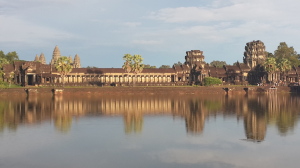 So. I went to Angkor Wat, in northwest Cambodia. If you’ve been here, you know how extensive it is. If you have not been here….it’s really extensive. Not just a single temple but dozens of them, some huge, some quite small. Lots has been written about Angkor Wat (Wiki) and researched (cool 3D imaging of Angkor Wat). And other than open mouthed wonder, I don’t have much to say about this visit beyond a small sampling of the hundreds of pictures I took. Too many to upload to this blog, but here’s the link for some of them on my Google Drive (Dave’s Angkor Wat pictures).
So. I went to Angkor Wat, in northwest Cambodia. If you’ve been here, you know how extensive it is. If you have not been here….it’s really extensive. Not just a single temple but dozens of them, some huge, some quite small. Lots has been written about Angkor Wat (Wiki) and researched (cool 3D imaging of Angkor Wat). And other than open mouthed wonder, I don’t have much to say about this visit beyond a small sampling of the hundreds of pictures I took. Too many to upload to this blog, but here’s the link for some of them on my Google Drive (Dave’s Angkor Wat pictures).
What I will tell you is how I got there. I took a bus from Phnom Penh to Siem Reap and then hired a tuk tuk to take me to my hotel, a very nice guesthouse run by Gary, that I found through airbnb (Golden Dynasty Guesthouse) . Ratha and Chandra, my new friends at the front desk, arranged for an English speaking guide for me, $35 for the day, plus a tuk tuk to drive us around $20. A good friend in Vietnam, Morgan, had given me a strategy: go in reverse order from what the tourists do. Skip the dawn East Gate at the Angkor Wat, which tends to draw lots of tourists, and start at Bayon then move back to Angkor Wat later in the day. I liked the sneakiness and contrariness of this plan, and suggested it to my guide, Densith. To whom had I paid a day’s wages. And he said, “Nice idea…No. We’re going to Angkor Wat first.” I’m finding, during these travels, that without a solid communication ability, it’s hard to change mindsets. And The Standard Tour For Day 1 starts at Angkor Wat. That’s just how it is. I had thought about just renting a tuk tuk and exploring on my own, but realizing how ignorant I am of the history and archeology, I decided the $35 would be well spent. And, aside from insisting that we STICK TO THE PLAN, Densith was a good guy and we got along fine. So off we rambled to Angkor Wat.
Honestly, the crowds weren’t too bad. And Densith had LOADS of statistics that he was insistent upon sharing with me. To a listener nearby, our conversation may have sounded like this:
Densith (earnestly): This wall is 356 meters long and was built in 1186, but that wall there is only 285 meters long, built by the king after that.”
Dave: How come?
Densith: How come what?
Dave: How come that wall is longer than the other one? Was the king after the first king lazy?
Densith: (pausing) No, I don’t think so.
Dave: I’ll bet he was lazy. (looking in an A.D.D. manner toward another building) Where do those stairs go to?
Densith: Um, that staircase was built in 1175, and has 99 steps, because 9 is an auspicious number. It goes to what they believed was Heaven, or the closest they could get to Heaven.
Dave: You mean that floor only about 50 feet up? Doesn’t look that close to Heaven to me.
Densith: (struggling to stay in control) Only the royal family could go up to Heaven.
Dave: Can I go up there now?
Densith: No. Those stairs are closed. Because tourists kept hurting themselves on them. But there is a special set of stairs around the corner where you can get up there. I don’t want to go with you, my knees hurt. I’ve done it too many times.
Dave: I’ll go without you then. Will you wait for me?
Densith: Perhaps.
Dave: Perhaps?
Densith: Ok, I’ll wait for you. Don’t take too long.
This was a fun tour.
You can see the pictures here….
Too small? PICTURES ARE ON GOOGLE PLUS HERE.
Here are some to whet your appetite… (and remember, click on them to embiggen them)
And then…..this happened.
Okay, enough whetting. Go see the pictures. PICTURES ARE ON GOOGLE PLUS HERE.
What I knew of Cambodia before I came here is sad. Spillover from the Vietnam/American war. Followed by genocide of their own people (3 million murdered/starved of a population of 8 million). Followed by invasion by Vietnam that stopped the genocide, but aside from that hasn’t done any favors for the remaining Kampucheans (interesting discussion about this between present day Cambodians and Vietnamese in the comments section of this blog post). This is a beautiful yet poor and sad country (Siem Reap / Angkor Wat is like an island in this, which I’ll report on soon).
I met two men. My tuk tuk driver in Phnom Penh, Teah, and my Angkor Wat guide, Densith. Born in 1977, when the Khmer Rouge was killing everyone, including infants, Teah’s family miraculously escaped the genocide, while losing all their property in the big relocation. Densith was born in 1973, so was a child then. His father was murdered, and his grandparents starved as so many did in the forced relocation to the country. For more background on the Khmer Rouge regime in the late 1970s, go here. But the quick summary as I learned it from these men who lived it was that the US/Vietnam war left the eastern part of Cambodia in ruins and instability, after many “illegal” bombings pursuing the “illegal” North Vietnamese whose Ho Chi Minh Trail supply trail went through Cambodia. I read that the US dropped more bombs on Cambodia than they did on North Vietnam (sources here, here and here). As a result, the existing Cambodian government was weak, and a school teacher named Pol Pot took over with an extreme vision of Communism. The Khmer Rouge divided the population up into “old” citizens and “new” citizens. The “old” citizens were the problem and were enemies of the state. They were basically the intellectual and professional, and just generally educated, social class. They mostly lived in cities, like Phnom Penh. The Khmer Rouge saw the only way to attain their vision of society was to forcibly move everyone out of the cities into the fields to work as farmers. Which is what they did.
Image Source://cityofwater.files.wordpress.com/2012/01/untitled.png
They also saw a need to eradicate the “old” citizens, and through systematic killing, did just that. In addition to outright murder, the city folks had no clue how to grow food in the fields, and so starvation was another cause. Again, in all 3 million of 8 million died during the late 1970s. In trying to make sense of this, in the same way I tried to make sense for myself of the war in Vietnam, I visited the “Killing Fields” memorial and “S-21”, the brutal school turned interrogation/torture center in PP (official site here). I saw horrific images, but will not include most of them here. I’m sure you can find the terror online. But here’s a sample of what I saw.
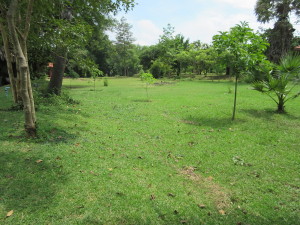
Benign looking now, but this is where many of the tens of thousands were killed, typically not with guns, but with crude weapons. Sticks, shovels, axes, etc. The site is just one of hundreds of killing fields throughout Cambodia. This one is where the biggest memorial is. Outside of Phnom Penh.
This only happened 35 years ago, so anyone over the age of 35 now…was here. And I didn’t meet, and talk, with any Cambodian (Kampuchean) that did NOT have some personal and/or family connection with tragedy from that time. And it still goes on. Landmines are all over the place, in the country.
Densith, my Angkor Wat guide, told me how the Khmer Rouge soldiers, on the move, would make camp and line the perimeter of that night’s camp with landmines for protection. And when they moved on the next day, they left the mines, unmarked. So these little caches of landmines are everywhere. Still. And people are still dying and getting maimed by them.
Several other people I talked to were quite adamant that the war is not over. They call it the “Cold War” with Vietnam, and their own Cambodian government the “puppets” of Vietnam. I have not had a chance to corroborate any of this, but the claims I heard more than once include:
Again, I haven’t corroborated any of these claims. These are the perspectives of a very few Cambodians. However, I did read in the local English language newspaper about the lack of progress made by the government in deporting the “Vietnamese illegals” (the newspapers’s term). If you’re interested in this issue, let me know and I’ll see if I can find some sources that seem credible to me.
Despite all that, without an exception, every Cambodian I met this trip was friendly, helpful and….hopeful. True, I’m a tourist, and a primary source of income. But I’ve been other places where that still didn’t matter. I really like the Cambodian people I met, and feel sad they have so few opportunities.
This was a hard piece to write after seeing what I saw, and talking to actual people who have personally suffered from this tragedy.
I was astounded at how big the Mekong is! It starts in the South China Sea and winds all the way up to SE Asia, with its source coming from a spring in Tibet. Who knew?
I didn’t go that far north, on account of it being so far north, and instead started my day tour in Mỹ Tho, which is about an hour south of Ho Chi Minh City by air conditioned bus! (Commercial pitch: if you’re looking for good cheap day trips out of Ho Chi Minh City, I can highly recommend Sinh Tours. I paid $12 for a day on the Mekong Delta, including lunch. And just $7 for the Cu Chi tour, lunch not included.) The river reminded me of my time on the Amazon out of Iquitos, Peru. Same big, wide brown water, with tropical vegetation growing on the shores and floating in huge clumps along the current. Hot, humid, rich smelling. Amazing clouds. The whole deal. I love being on these rivers!
People of course have been living here for millennia, and despite modernity, still do things like grow fish in floating houses, like above. No one lives in these houses, just fish!
Like other rivers, the boats plying the waters are low, slender rigs, that do a lot of putt putting, rather than roaring. They have to contend with widely fluctuating water levels, so don’t draw too much. While I was ON my boat taking this picture, this is what mine looked like.
I wasn’t sure what these were. I don’t think they were fishing houses. And I’m not sure that people lived in them. But they looked awfully rustic and so I present them to you for your speculation!
Just a working family, on the river.
I’m not real big into selfies, I always think I look like a a dork. So I had Vo, my tour guide, take this one of me doing my Huck Finn Goes to Vietnam pose. Our boat was able to go into some of the side rivers, on our way to lunch, and some interesting “factories”: rice chips, coconut candy, baskets, and of course tourist souvenir shops!
Looks tropical right? Lots of bugs right? Hot bed of malaria and dengue fever carrying mosquitos, right? So…not so much. At least not to me. I’ve been in SE Asia for nearly 3 months, and have YET to see a damn mosquito. I had the same issue in the Amazon, nary a bite. I’m not sure what this means, and I’d love to hear from you if you do. Is my body scent repulsive to bugs? I’m grateful, but confused. Anyway, I was expecting to find clouds of bugs in this particular turn of the river, but all I saw were butterflies and a few dragon flies. Odd. Not many birds either, which still confounds me. With all the water and fish in that water, I don’t get why I’m not seeing seagulls, or other water birds. In the US, those things are everywhere. Anyone know where the seagulls are in Vietnam???
So this was lunch. A river fish, cooked and presented thusly. I had no idea how to approach it, but thankfully I didn’t have to. A restaurant worker expertly pulled succulent meat out of it, and rolled it with vegetables and spices in rice paper to make a fantastically tasty fat spring roll!
And of course, making a living on the Delta doesn’t mean you have to fish. We were regaled by these two singers, and their accompanying band (a guitar, a flute and bass – all acoustic). Vo, my trusty guide, loosely interpreted for me. Songs about love, and romance. And love and romance gone wrong. So, Vietnamese COUNTRY songs! They played for tips, and I’m happy to say that our group was generous.
People live on the river, and since the river rises and falls with the rains, they have to build berms to keep it from sloshing over into their homes.
Back on the river, these guys swam past. Not wild, but domestic ducks, chickens, and cows would wander by wherever we were. I’m no farmer, so there must be some secret to getting them back.
I love palms!
At one of our last stops, we came to a rice chip making factory. First, they grind rice with water to create a paste. Then they spread the paste onto these hot surface (top picture), and cook it for awhile. Then they lay the resulting cooked rice “big chip” onto bamboo to cool and dry. And finally they break them up to look like the bottom. I LIKE rice chips. Very tasty!
I took many many more pictures of this trip, but this gives you taste of what river live on the Mighty Mekong is like.
Cu Chi. If you’re any kind of aware of the war in Vietnam in the 1960s, you’ve heard about Cu Chi, a vast network of tunnels and bunkers in the hills north of Saigon (now Ho Chi Minh City), where the North Vietnamese regular army, and the Viet Cong hid out. You can read all about the place here. If you want to see a Communist video about the tunnels and the war, rather than all the tourist videos, here’s your link. I had heard about them for a long time, and have been deeply curious how this placed worked. So I came up on a day tour out of HCMC, and wandered around. This is what I found – in pictures!
This was creepy when I walked up to it! Mannequins of NVA and VC soldiers reenacting what they did when they weren’t being bombed by B52s. They lived on very little food, maybe a couple rice balls and tapioca (see below). I still don’t know how the Vietnamese people, even today, can wear jackets when I’m sweating like a mafia accountant accused of embezzling. I don’t notice them sweating. Very odd. It makes a HUGE difference being in the shade though, and a when a little breeze comes up…you feel like life is worth living again.
Some of the tunnels were very deep, maybe 30 meters down, and of course they needed air down there. So throughout the system they’d dig air holes in random places. Sometimes in natural mounds like this, sometimes in mounds they made. For the most part, the holes faced east, where the wind usually came from (the South China Sea). But during an attack by the US or S. Vietnamese forces, they would step away from these holes because gas would get blown into them by the soldiers.
One of the tactics the NVA and VC would use would be to shoot at enemy soldiers on the ground, and then disappear into these trap doors, quickly covering themselves up with camouflaged lids. They demonstrated, and even though I saw where the hold had been, I couldn’t see it once the lids were in place. Sometimes they’d pop out, shoot, grab whatever weapons they could, and then jump back down in the hole. I can’t imagine how frustrating and terrifying it was.
This, I was told, is what the Cu Chi soldiers lived on. The food on the left is ground peanuts with spices, and on the left is tapioca, a kind of root. I ate some of both, and they tasted good! But 3 times a day for months on end? Still, it kept them alive, if not in great health.
I’m not sure they wore Vans, and I know for a fact that they’ve embiggened the tunnels so fat Westerners can get through, but this is what a tunnel looks like with someone in it. I knew it would be a tight fight, and not so comfortable to walked hunched over like a drunk looking for his keys. But I thought underground would be cooler. Not so much. The sweating became embarrassingly torrential in this thing. Again, how they lived in here for months, or in some cases years, I can’t imagine.
At some point, the US decided they needed to bomb the bejesus out of this place. The NVA and VC used it to stage attacks on South Vietnam targets, and that was intolerable. So they sent out B52s to drop tons of bombs. Here are a few that did NOT explode. These unexploded bombs turned out to be excellent resources for the NVA and VC to use to make their own weapons – mostly booby traps, but other kinds of more offensive weapons.
This is one of dozens of bomb craters I saw still here, made by bombs dropped from B52s In fact, the little sign on the tree says so. It turns out that these craters eventually fill with water, and locals – after the war I think – would use them as fish ponds to grow food.
This tank was blown up by a mine, and stayed here. So there were plenty of ground battles on Cu Chi as well as bombings.
Because of those ground battles, the NVA and VC put in lots and lots of booby traps. They weren’t designed to kill, just maim on the theory that they didn’t need to kill to take out US soldiers. So if you were a US soldier, or S. Vietnamese soldier, in addition to VC soldiers popping out of trap doors and shooting at you and then disappearing, you’d have all sorts of these contraptions around just waiting to skewer you with bamboo punji sticks.
Here’s one example, called a Bear Trap. It had a swinging door that you couldn’t see, because it was covered with leaves and stuff. You step on one edge of it and…..
This is what you fell into. Again, hundreds, if not thousands of these things around.
Another thing that continues to be deadly are land mines. Still around, and still blowing people up. No one knows where they are, exactly, other than “over there”, and there haven’t been enough resources to clear all of them. This is more of a problem, I learned, in Cambodia, than in Vietnam. But still a legacy of the war here.
That’s it for Cu Chi. While I marveled at the ingenuity, industry and deprivation of the inhabitants, I came away with an even deeper sense of how stupid- and utterly inhuman – wars are. (Heavy sigh….)
I’ve been a bit frustrated during this trip that I haven’t been able to travel slowly, by rail or bus. Instead, for a lot of reasons, I’ve only been able to fly. So I was keenly wanting to take the train on my way south from Da Nang, to se the countryside!
This first bit is for a cool site I’m using, seat61.com, which is all about taking the rail around the world. I thought Mark’s readership might like a bit of detail about this trip. Following this review, I’ll add some additional commentary for you, my loyal readers!
———
Bought my ticket online at vietnameimpressive.com, $75, about the same as a flight. Straight forward purchase process online. I booked a week ahead of time, and they delivered my ticket (along with travel tips), to my hotel in DaNang 2 days before my train. They recommended we get there an hour before, but really, 15 minutes would be fine, if you have your ticket. Waiting room is no frills, but comfortable. There’s a convenience shop in the DaNang station where I bought water and carbo snacks. The train boarded at 1:00pm and left promptly at 1:15pm. (A word about the travel tips. None of their dire warnings happened for me. No one asked for more money, or was in my seat.)
I had Coach 10, lower berth 22 (which put me in compartment 6). The ticket taker told me in English where to go (“Go to six!”). The compartments on this train are strictly sleepers, no conversions. There are four sleepers in each compartment, two up , two down. I found mine, threw my luggage underneath, and settled in.
When you get in your compartment, the linens will likely be used, but just wait. As soon as you get moving, the attendant will come by and give you fresh ones, which you put on. The cabins are clean but not new and at all fancy. I’m 73 inches tall and my sleeper was just long enough and wide enough, about 24 inches wide. Sitting was comfortable, albeit in a legs crossed position. My head didn’t reach the berth above me. There are two power plugs in the compartment. No wifi, but cell coverage worked fine so I was texting with my friends all night, and using my phone’s GPS to see where I was. Definitely reserve a lower berth if you can, it’s simply more comfortable (ie, you get the use of the floor). There’s a short table between the two lower bunks, which was nice to put snacks on.
You can close the door to your compartment, I left it during the afternoon, to just look out the window from my sleeper. At night, I closed it, and turned off the lights. For the first few hours of the trip I shared the cabin with one nice young woman who mostly slept. When she got off, two other smiling women got on for the rest of the trip. Then around 10pm, a man got on the bunk above me. Not sure if he was smiling or not. All reserved seating. All I had to do was move my feet over a bit so he could get a leg up. Again, they mostly slept. Neither my Vietnamese nor their English was strong enough for conversation.
The night went uneventfully, although the 2 inch thick mattresses weren’t really great for my 56 year old bones. So I was little stiff when we arrived, right on time at 5:30am, in the HCMC station. I slept in my clothes, which seemed easier since I didn’t know my sleeping mates – no curtains between the bunks. The sheet didn’t stay on during the night so I’m glad I had my clothes on. While the mattresses looked clean, who knows? The good news, no bedbugs or anything creepy crawly.
Summary: a no frills, adventurous alternative to flying, at the same cost. 16 hours, most of it in the dark. Bring your own entertainment, including a flashlight if you’re bringing non electronic reading.
——- Further commentary for my friends!
The reason I wanted to take the train, instead of a flight, was to see the countryside. And for the 4.5 hours of daylight, I was not disappointed. Granted, taking pictures out of a speeding train isn’t the best way to show, but here we are.
My train stopped every hour or so for a town, and preceding each was an announcement in Vietnamese. Except one time. It was a warning, in English as well as Vietnamese, explaining the reasons someone might get thrown off the train. The usual…”no ticket, trashing the place, bothering others, drunkenness..” And then: “those carrying corpses or body parts”. Hmmm. I look next to me, and notice, with fresh vivid insight, the large Styrofoam box, tightly wrapped with packing tape, on the floor just 2 inches from my face, as I sleep. That a new passenger had been perhaps a bit too furtive in moving on. My imagination, in my half asleep state ran with it. Taking Grandpa back to his ancestral grounds for proper burial, in the most cost effective mode available? I was flummoxed. What are ones options? I couldn’t very well ask the woman , “is there someone you knew in that box?”. I didn’t know Vietnamese well enough, and the Vietnamese I do know is all in the context of dining. Which is not the proper context at all. So….I just let it go. I just let…..it…..go. And went back to sleep.
I hadn’t really done a good job of preparing my food for this trip, aside from a roll of Ritz crackers, a bag of peanuts, a couple Snickers bars and water. So when the man with the rickety cart rolled by yelling out who knows what, I hailed him, “Em!” (which is sort like “sumi masen” in Japanese, only “em” means the person you are addressing is younger than you, which nearly everyone I meet on this trip is). Em! He stops in mid ramble and glances at me in my cabin. And then he gets this look that I get a lot which I have come to interpret as “You are a big strange looking beast. I suppose I need to deal with you, but I don’t know English, and don’t want to know English. I’m guessing you know even less Vietnamese. And it’s a hassle dealing with beasts like you. So here I am. Stuck with you. Sigh….What do you want?” All of this I pick up in a glance. Amazing. However, he is shocked and then laughs with glee when I simply say “tôi muốn ba gà”. (I want 3 pieces of chicken!). It astonishes me how so much joy and acceptance and downright hospitality I’m getting from the most hardened customer service people here when I trot out even a tiny bit of Vietnamese. With the newfound warmth of an old friend he dishes me up 3 fried legs of chicken, and tosses in a “chicken on a stick” (think shawarma) to boot. At that moment, a mouse decides to run the length of the coach – we see it coming – right under our feet, and disappears under the garbage can at the opposite end. We both watched it run past, and then look up at each other. My look was, I’m sure, one of “uh….really?”. He laughs and says something that he found amusing, Then the moment shifts and he gets that worried look back as we approach the payment issue. So I say to him, “bảy mươi?” (Seventy?) And he lights up again and says “no (in English!), NAM mươi!” (Fifty!) A deal is struck and I pass him the money he wants. 3 pieces of chicken and a “chicken on a stick” for $2.50. Not bad. As I return to my berth, he continues moving down the coach and I swear I heard him cackle in glee, shaking his head and looking back at me, not once, but twice, utterly bemused. The chicken wasn’t bad.
I took a video outside the window with my Smartphone. Not great quality, but you’ll get to see bucolic Vietnam, with rice paddies, water buffaloes, and mountains.
And that was it!
I know when my life is not in the center. I get desirously involved with my relation to some achievement or system that is tangential to the real centering of my life. And I know when I’m on track – that is, when everything is in a harmonious relationship to what I regard as the best I’ve got in me.
In the Grail legends, the land of people doing what they think they ought to do or have to do is the wasteland. What is the wasteland for you?
One of the joys of this journey is the time to read. I’m reading both fiction (just finished The Good Earth, by Pearl S. Buck; only got through a third of Catcher in the Rye, too whiny for me; LOVED 100 Year Old Man!) and nonfiction (in particular Campbell and Pema Chodron). These books all seem to have a common thread: how COULD one live a life? And I’m picking up a thread from the past year where I really challenged myself to ask Campbell’s questions: what is the wasteland for me? What achievements or systems am I buying into that keep me off center? For most of my life I have made what I thought at the time were good choices, mindful of my roles and responsibilities. I regret little. AND, at the same time,…..along that path I’ve picked up assumptions, and stories, and beliefs and values that no longer serve me.
So I did an exercise last year in the lead up to this journey that I’ll share with you, although at the time I thought it was going to stay private. I wanted to examine all of my assumptions and operating beliefs, no matter how naïve, stupid, awkward or even plain wrong they were. As long as a word or phrase rang true for me, at a core intuitive level, I wrote it down. True in the sense that, yeah, I DO believe that belief, or act that belief out, or fantasize about that belief in a way that creates my reality. I realized yesterday, after reading the Campbell passage, that I was striving to answer the question: What is the wasteland for you?
I asked myself three questions:
First I meditated and got quiet, real quiet. I wanted to get quiet so that the filters, stories and rationalizations that typically run through my brain constantly wouldn’t drown out the sometimes whisper of my center. (Can you tell I’ve lived in Northern California a long time?). Then I just listed to what came to me, never filtering, never disagreeing. Basically I did an individual brainstorm, with the same rules as group brainstorming. And after about 30 minutes, this is the list I came up with:
I have told myself that I am supposed to be:
Again, I wanted to get at those assumptions and beliefs that I had taken on over the years, without judgment. Then I took a breath, and asked the next question.
Which of these do I actually want to be?
For this I just cut and pasted pretty much exactly what was in the first list. No embellishments. (Well, #9 summarized some similar beliefs.)
Then I did a short meditation, and asked the next question.
What ELSE do I actually want to be?
Campbell answered his question this way: “I know damned well what the wasteland would be for me: the academic approach to my material; or a marriage to someone who had no thoughts or feelings for me or my work. I find working for money to be the wasteland – doing something that somebody else wants instead of the thing that is my next step.”
I will continue to work at my answer to Campbell’s question. For now, my wasteland is where I find myself living in my old beliefs.
What’s your wasteland?
Xi’an is an Important City in China. Here are the opening lines from the Wikipedia entry:
“One of the oldest cities in China, with more than 6,000 years of history, the city was known as Chang’an before the Ming dynasty. Xi’an is one of the Four Great Ancient Capitals of China, having held the position under several of the most important dynasties in Chinese history, including Zhou, Qin, Han, Sui, and Tang. Xi’an is the starting point of the Silk Road and home to the Terracotta Army of Emperor Qin Shi Huang.”
Most of you have heard of it because it’s where thousands of terra cotta soldiers were buried with the China’s first emperor in 300 BCE, that guy Qin. I’m including just a few pictures of the chalky soldiers that greeted us with stony expressions, since you can get all you need with a search here.
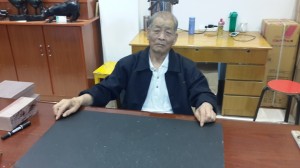
The Guy: This is the farmer that discovered the site in 1976. Despite his playful demeanor, and the sign that said, “No Autographs!”, I got his autograph! But since I can’t read Chinese, I’m not really sure what he wrote.
But Xi’an is much more than these dusty relics of a past megalomaniac’s vain vision. In nearby Yan’an live a people who have dwelled for millennia in caves carved out of mountains – and still live in them – although the family we visited also had a house in front of their cave. The mom (pictured below on a nifty tractor) preferred to live in the cave while her daughter-in-law and grandchildren preferred to live in the house. Her son was away working in a coastal city, and her husband passed away. They make their money showing off their home to our tour agency, as well as growing and selling persimmons. ALSO featured below.
Xi’an is also known for it’s culture, and so we saw a wonderful show featuring music, dance and theater of the Tang Period at the – surprise! – Tang Palace Theater. This is something I really wanted to see. I know it’s touristy, but I like music and theater and wanted to see traditional forms of it. Not just the ubiquitous K-Pop like genres. This was a dinner theater, retail price about $70 per person, although I’m sure our tour agency got a smoking’ hot deal. The food was dim sum, which was tasty. However, the highlight of the evening (aside from the show) was our grumpy, sullen server who went to no lengths at all to hide her displeasure at, we never found out. She looked on our table with dripping disdain, and it became a Thing for us to see how grumpy she would get. No tip for her!
Our penultimate stop in Xi’an was the Great Wild Goose Pagoda, originally built in 652 to house the original Buddhist texts and statues that Xuanzang (remember him? Devout, spoke softly, but could whip your butt and take your money in chess.) brought with him from India.
Pictures of Pagoda – forthcoming!
Our final stop in Xi’an was the Muslim Street, where the oldest mosque in China hid amidst the warren of tiny alleys, streets and walkways, filled with every conceivable product or food. I bought a pair of fake Beat headphones for $3. Score! And there were lots of these knock offs around. Walking through this section of town was intense – sometimes dark, continually noisy with yells, honking and sizzling from the grills. I loved it!
Pictures of Muslim Street – forthcoming!
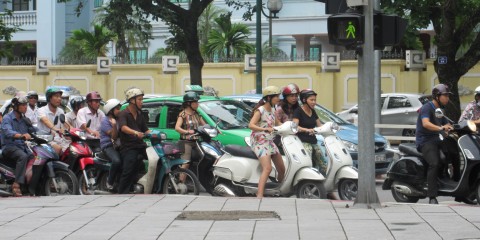
For those of you who have traveled abroad, or perhaps visited Miami, you know that much of the rest of the world treats traffic laws as a quaint yet utterly irrelevant feature of modern society. Vietnam provides a case in point. When you first walk on the streets, say in the Old Quarter of Hanoi, you are struck, if not by a moving vehicle, then by the mindboggling number of near misses about your person. Chaos!
As a little background, realize that you start with a vast number of motorbikes, that came on the scene well after the roads were built for a society with mostly bicycles in mind. In Hanoi alone, for 7 million people, 4 million of these things zip around (true fact as reported by Sunny, my tour guide). Each of these has one or more drivers, who may or may not be thinking of the esoteric concept called “rules”.
One possible rule to follow, when it’s convenient, is to drive on the right side of the road. But there are many MANY other factors that precede convenience in navigating the roads. Including whim. For your edification, I have recorded the following.
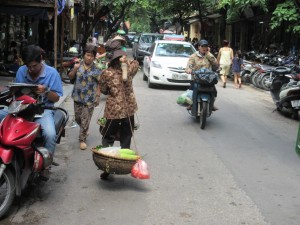
How To Cross The Street When No One Will Stop For You
That’s it for now. Stay tuned as I explore the rest of SE Asia traffic patterns. Next up: an overnight train ride from Danang to Saigon (or, for the truly stodgy, Ho Chi Minh City).
As part of my consulting plan here, I decided to look at my clients processes to see if we can do some redesign. Tooth whitening has always had an allure to me, for some reason I really don’t want to get into here, so I signed up to get my choppers whitened as a way to learn the process. The idea of Medical Tourism has also intrigued me too.
What did I find?
Finding 1: The East Meets West Dental Center staff, all Vietnamese, provide as skilled and modern dental service as my dentists in the U.S. They took the same care, used the same instruments, went through the same processes, and had the same results as I’d get in the US. Nothing in the staff’s service, other than the fact that their first language is Vietnamese, was different. And the customer facing nurses and dentists spoke good enough English to make it a non issue.
Finding 2: Since this is a nonprofit social enterprise, nearly all of their equipment is second hand (my chair came from a donor in China, the one next to me came from a donor in the US). But…..a chair feels like a chair, regardless of how many people have sat it in, right? Lighting lit, trays held stuff, instruments intruded in my mouth as usual. No differences. Supplies such as gloves, sponges, etc. were, of course, new. Who wants to re-use a pair of gloves??? Not me!
Finding 3: It’s a LOT cheaper! This office did a process called Vital Whitening, which cleans your teeth, applies a powerful peroxide gel on the teeth, and then uses special lights to activate the gel and increase the bleaching of my nasty coffee stained teeth. Took about 2 hours. In the US, and I priced it before leaving, doing this in a dentist office costs anywhere from $600 – $1,000. Here, in lovely Danang Vietnam, I paid $85. Makes me very happy.
Finding 4: I LIKE thinking about what to do with the $500-$900 I just saved! And I’m happy with my treatment, my teeth are much brighter and all with no pain or suffering. I just can’t have coffee, tea, coke, or curry for 10 days. Harumph!
I arrive in Hanoi wondering what I’ll find. I mean, my country bombed the hell out of these people 45 years ago, in a war that most, including Robert McNamara, admit was a horrific mistake. Hanoi. From the time I was 7 years old until, really, 17, the Vietnam war was always on our mind. Walter Cronkite reporting body counts nightly. War protests in Ann Arbor down on campus. Vietnam. In 1965, when I was just a little kid, a 20 yr old who lived just 3 houses down, David McKenzie, was killed in Vietnam after jumping on a hand grenade to protect his friends. I had dreams of the Viet Cong in black pajamas coming for me. And as the war kept going, and I approached 18, the fact that the draft was a lottery didn’t help my fear of having to go myself. I remember vividly one day, I guess I was about 10, sitting alone in my bathroom, terrified that I would have to go to Vietnam. Eventually, movies like Platoon, Red Line, Apocolypse Now, even Good Morning, Vietnam, brought visualizations of what that war was. And all of this was supposed to be coming from the evil Communists led by Ho Chi Minh, and backed by the equally evil Soviets.
So when do I happen to arrive in Hanoi? Why during their national holiday, of course, celebrating their independence from the French, and Ho Chi Minh’s historical speech declaring the establishment of the Democratic Peoples Republic of Vietnam! The red flag with the yellow star in the middle, that I remember anti-war demonstrators waving on campus during the protests, the same flag that for many instilled fear of the inevitable march of Communism through the “Domino Theory”….these flags are out every where I go today, like we put up our American flag on July 4.
So with this as psychological baggage, I walked up to the passport control at Hanoi airport, truly nervous. I know….I’m not ignorant (well, with this sort of thing). I’ve read enough and talked with friends and people who have been here recently. Their reports: Since 1995 and Bill Clinton’s visit, Vietnam has moved on, they truly want to develop their society, and nearly all see most of us Americans as helpful in that. The war was a couple generations ago. Yet, memories are sticky things, and mine, from the musty recesses of my child’s brain, was that Americans came to Vietnam to die. But the woman at the passport window simply looked at my USA passport, smiled (okay, it was more of a bureaucratic perfunctory grimace), checked my visa, handed it back, and said thank you. In English. Thus began the unraveling of my musty memories of Hanoi.
Today I went straight to it. Visited the Hoa Lo prison, the notorious “Hanoi Hilton” that tortured US pilots, including John McCain. Walked up to the ticket booth, paid 20,000 dong (<$1) and just walked in. Remember a few posts ago where I talked about being in an historical place and connecting to it? I did that here too. Most of the prison museum is about how the French imprisoned Vietnamese dissidents (patriots, as presented in the museum posters). And it wasn’t pretty. Even have on display the guillotine they used on some of them. I learned that most of the prison where the American POWs were kept had been torn down for a new shiny shopping mall. But I found two rooms dedicated to the Vietnam War time. Now whether or not the display was propaganda depends on which side you’re on. All I can say is that there is no mention of torture, but plenty of mention of the destruction the 1972 Christmas bombing program (Operation Linebacker II ) did to Hanoi and its residents. And, while being a POW wasn’t great, as the tour guide I was eavesdropping in on explained to the couple from Missouri, the prisoners “were treated well, and could do things like read books, play cards, play basketball, decorate their rooms, ….”. The stories of torture are pretty well documented elsewhere. Anyway, I’ve seen the movie Hanoi Hilton, and it was strange being in that same place. What I left with was a feeling of how badly we humans treat each other. Sobering.
I took more pictures, and may post them eventually, but they’re kind of depressing. If you’re interested, search here.
[A fascinating story of resolve and ingenuity, that I have learned since I wrote this, is that of one particular POW, Jeremiah Denton (who later became a US Senator). During a 1966 TV interview that the North Vietnamese intended to use a propaganda, he blinked out, in Morse Code, “T-O-R-T-U-R-E” without his captors knowing it. A Navy intelligence officer watching the interview noticed it, and that’s how he communicated the real story of what was happening in that prison to American POWs. See clip here. And story here.
After the prison, I needed a break. It was lunch time, so I wandered around and thought I’d found something new and adventurous, but it turned out to the be the same great restaurant I’d been to the day before with Forest, my new Chinese truck sales man buddy (who I’d met in the hotel over breakfast). Decided that I wanted to branch out and try something different so ordered up Pho Ga (chicken noodle soup), not so different, aaaaannndddd…. Green Papaya Salad with Sparrow. That’s right, I ate sparrow. It did NOT taste like chicken , because it was WAY crunchier than chicken. I declined eating the head and beak. But the taste was very nice, rich and slightly gamey, in a good way. As you can imagine, there wasn’t much. I think I got one sparrow, not a flock. Anyway, tasty meal for less than $10, including beer.
Next stop today was the Army Museum, which I heard had a lot of Vietnam War era weapons but not much description. And that pretty much turned out to be true. They had lots of captured materiel. Tanks, jets, howitzers, and plenty of smaller weapons and equipment captured at various times. All of the signs on the US weapons talked about the damage they had done, while all of the Vietnamese weapons talked about the victorious battles they had helped win. Fair enough, it’s their museum. What was odd was seeing specific weapons (like anti-aircraft guns) with the stories about which planes they had shot down, piloted by which US servicemen. With names. I don’t know what to say about this, except it felt odd reading the other side of the story. There is a bust of an old woman, who was quite famous, I guess, for having lost 9 brothers and sons to the wars against the French and US. Can’t imagine losing that many brothers and sons.
Across the street from the museum was a big old Cold War statue of yours and my favorite social engineer, straight from 1919, none other than…….one V. I. Lenin himself! I think this must be one the last remaining public statues of him in the world.
In 2014, when even the Russians don’t have many statues of him any more, as I’ve read, yet his presence in a place of honor just struck me as anachronistic.
My last stop today was Thuc Bach Lake, where Hanoi residents and soldiers hauled John McCain out of, after shooting him down as he was bombing Hanoi . Again, a weird place to be. I mean, a future US Presidential candidate had been pulled out of this lake in front of me, body broken, and near death. Then put in the Hanoi Hilton.
So that was my day of connecting to the Vietnam War in Hanoi. And what it did for me was resolve and reset the decades long mental images and beliefs I’ve carried of this place. This, I think, is how we get over any obsolete and purely invented emotions and thoughts. Get in touch with the reality, and get out of our Shadow thinking. The stark contrast between these images, seen in person, to the experience I’ve had with today’s Hanoi and Vietnam, did the trick.
So next post, TODAY’S Hanoi, and Vietnam! And I think I’ll start off with the fascinating, crazy, almost unbelievable until you see it world of traffic, and scootering!
If you’re a going to be a regular reader of this blog, prepare yourself for some rather raw thoughts from me. I’m at the point where I’ve held on to so many identities so cautiously (son, husband, parent, teacher, consultant, “responsible got it together friend”) that this year is my year of letting all that go and reclaiming what’s beneath. Mostly it will be a whimsical travelogue, because I like to write those kinds of posts, and I want you to be entertained as I am by what happens. But it will not be all rosy and peppy. I’m going to put some very personal stuff up here, partly because I need to write it, and partly because putting it out to all of you is an edgy kind of honest risk that I want to take now. Since some of you have decided or been forced to, for better or worse, to join me on some part of my Life, (Thank you!), let me assure you that the only person I’ll embarrass is myself. And I’m no longer really worried about the consequences of that.
So, let’s begin. There’s an element of wanting to improve myself on this trip. To somehow find wisdom, to come back, like Moses on the mountain top, a changed man. My Ego is doing a good job on me of building expectations of enlightenment, that I will somehow gain something from this trip. That I will do such good deeds, think such deep and profound thoughts, act in such mature and evolved ways…that all that justifies this year long journey.
Instead…..I’m just sorta not doing anything. I’m meeting people, but not deeply. The language barrier, and my shyness prevent that. I’m not the Worlds Most Interesting Man here. I’m not Dave Barry, or Mark Twain, or Joseph Campbell, or Bill Bryson…. This morning I puttered around my tiny Hong Kong airbnb room wondering what to do (I’m talking TINY…the bathroom is in the closet!). Made up the story to myself of “going to the coffee shop to write” to give meaning to the day. Presumably to write deep thoughts. Instead, I wandered around the crowded sweltering streets, got mildly lost, came across a post office and mailed home a box of souvenirs from China, walked into a random low rent, claustrophobic indoor shopping mall (intensely populated by desperate Asian Indians who all implored me to buy women’s bags – “good quality”, watches – likely fake, or some other such stuff that I have no interest in).
I checked out the menu from the Outback restaurant and found myself saying ,”Really? You’re checking out Outback? Where is your adventure? Aren’t you supposed to be diving into some back alley to try Andrew Zimmerman or Anthony Bourdain delicacies, have a few beers and then like Ernest Hemingway come away with stories about a Cambodian man I’ve met, same birthdate as me, who escaped slavery on a Thai shrimping boat to make his way on a rickety craft on the South China Sea with 200 others to Hong Kong, where he’s scraping together a meager yet honorable existence so he can send back his remittances to his extended family of 15 in Cambodia? And we become fast friends, vowing to stay close the rest of our lives here on earth?” Jimmy Buffet “African Friend” stuff! But no.
Instead I’m sitting here alone, at a short table, in some random ex pat bar named Mes Amis on Ashley Street , in Tsim Sha Tsui (Hong Kong), surrounded by mostly non Asians around me, drinking a second pint of Asahi, for godssake!! THIS is the Big Year Traveling Around the World? THIS is going to make me an Enlightened Global Citizen? Harumph…
I wonder why I did this. I’m not scared or sad or anxious. I believe I can “not do anything” anywhere in the world. (Well, maybe except for war zones, where I’m not too interested in going to at the moment). This Trip Around the World became a thing in my mind a couple years ago and when nothing and no one resisted it, that idea became a Thing that gained its own momentum. And once ideas like this get momentum, you just get carried along by it.
So here I am. Sitting alone in a bar that looks no different from bars in San Francisco, or Ann Arbor, or Munich, or even Dubai….with drunk ex pats, over half of them squinting into their smartphones. Even the music is the same as it is in those other places…some sort of Western Top 40 pop tunes (with some classic stuff too, Santana’s Black Magic Woman is up now!) And, after a month of “checking out East Asia”, I’m ruminating on the questions: Why am I here? Why am I doing this?
Okay, so it’s true that I begin contributing again Sep 4 in Danang, Vietnam. Offered my pro bono business consulting services to the East Meets West Dental Clinic, whose staff seem genuinely excited about my coming. For 6 weeks.
So I’ll get to something meaningful (ie, contribution) soon. But this past month of touring Japan, S. Korea, China and now Hong Kong (okay, still part of China but feels MUCH different)…. this past month of touring has left me wondering why I’m doing this. It’s nice to SEE stuff (see previous and future blog entries). But is that enough? Shouldn’t I be improving something? Or making an impact of some sort? At the very least, being 56, shouldn’t I be in the prime of my earning potential, gathering the bucks so I can retire comfortably? I’m not rich now. I can’t retire unless I buy an RV and live in Quartzsite, Arizona. I should be making money, right?
But there was something in my awareness, over the last few years, that said….why not? These are the thoughts that have been coming back to me time and again: “You can always make more money. You can’t make more time.“ “If not now, when?” “You’re a global citizen, not just an American, so get to know the rest of the world” “ I feel more comfortable with the sensibilities (selectively chosen) of the rest of the world than of the strident chest thumping of American superiority political discourse.” (okay, that last one isn’t as pithy, but….it’s there). “Isn’t it just plain cool to know that I can live in different cultures and worlds, and connect with people from those different cultures and worlds? So get out there and do it some more!” “Your career is kinda stalled now, so why not?” “I can live cheaper on the road, than I can in SF, so this is a shrewd economic choice!” “I’ll always be a dad, but my sons don’t need me they way they used to, and it’s probably better if I’m gone for a year”. These are the questions that pushed me along to leaving everything – and everyone – to go on this journey.
New tune! Neil Young’s Keep on Rockin’ in the Free World filling the bar as one guy hauls a too drunk friend to the bathroom in the back of Mes Amis.
There are no conclusions to this sort of musing. But this sort of musing may be THE reason why I am taking this journey. To give myself space from the urgencies of making a living in the Bay Area to peel back the layers of ossified beliefs that 56 years of living has accumulated.
If you’ve read this far, what do you think? What opportunities do you feel a calling to give yourself, to lay bare and strip away the stories and filters and assumptions that you’ve accumulated over your time here on earth so far? And what would you do with a year away from everything, except yourself?
Take a good look at that picture again. Where in the world is Dave? Nooo…not LA. Not Florida. Give up? Sure you do!! I’m in Hong Kong Disneyland Resort, home of one of 3 Asian Disney theme parks. How many of you knew there were three? Tokyo was the first, then Hong Kong and they’re building a new one in Shanghai. And I’m here to report on the one in Hong Kong.
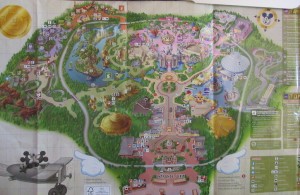 I have no official numbers for these things, but I’d say the Hong Kong park is about 67.8% of the size of the one in Anaheim. The same layout and features: Main Street USA, Adventureland, Tomorrowland, Fantasyland. Rides that are the same: Small World, Thunder Mountain railroad (called Grizzly Peak Railroad here), Space Mountain, Jungle Cruise, Disney Railroad, a tree house (in LA it’s called Robinson Family Treehouse, or used to be, here, it’s called Tarzan’s Treehouse).
I have no official numbers for these things, but I’d say the Hong Kong park is about 67.8% of the size of the one in Anaheim. The same layout and features: Main Street USA, Adventureland, Tomorrowland, Fantasyland. Rides that are the same: Small World, Thunder Mountain railroad (called Grizzly Peak Railroad here), Space Mountain, Jungle Cruise, Disney Railroad, a tree house (in LA it’s called Robinson Family Treehouse, or used to be, here, it’s called Tarzan’s Treehouse).
What’s different? Instead of Frontierland, they have Grizzly Gulch. Instead of New Orleans Square they have Mystic Point (more of a global explorers club theme, like “80 Days Around the World”). Instead of Toontown, they have Toy Story Land. Instead of Tom Sawyers island they have Rafts to Tarzans Treehouse. For rides, they have a really nice ride called “Mystic Manor” which is a fusion of Haunted House (ride and building set up) and Indiana Jones (adventure motif). I really like this ride and it could easily work in the US parks.
What don’t they have? Tiki Room, Indiana Jones, Star Tours, Pirates of the Caribbean, Splash Mountain, Hall of Presidents / Mr. Lincoln (duh), Country Bear Jamboree, the Golden Horseshoe Saloon, the shooting galleries, the Mark Twain boat ride, and probably some other stuff. Look it up if you really care.
They have some pretty spiffy rides in Toy Story Land that they don’t have in LA. RC Racer, a ride on a U shaped track that slides up and down and up and down, forwards and backwards, forwards and backwards. The Toy Soldier Parachute Drop, where you go way high up in the air and then free fall. And the Slinky Dog Spin. Which is sort of like a Tilt A Whirl, without the spinning. Tomorrowland has a fun Encounters With Stich show, and a laser shoot up ride called Buzz Lightyear Astro Blasters. And, for nostalgia buffs….Autopia!
What’s most different is the food they offer up. Where LA has just popcorn and cotton candy here they have popcorn, cotton candy AND packets of dried squid and shrimp balls. Yum!
Here’s a sampling of tasty dishes offered around the park. Not the same as in the US, eh?
One other design feature that strikes me as odd. Clearly Disney has put lots of money and care into making this just as high quality as any other park, albeit slightly smaller. However, lining Main Street towards the Enchanted Castle, they’ve opted to use painted screens for some of the facades, rather than “real” wood, paint and window facades.
Not sure why they did this. It doesn’t LOOK like they’re doing construction behind it, and inside are real retail stores. But it had the effect on me, as I walked down the street, of cheapness. And so I expected a less than great experience (which changed as I actually went through the park). So, who knows?
All signs have both English and Chinese. The Jungle Cruise had two lines, one for Chinese speakers and one for English speakers. The line for the Grizzly Peak Railroad rollercoaster was about 15 minutes long. But since I was a single, they put me in a separate line to fill in. I was one of just 4 people in that line. In the US, that line would be almost as filled up with families and groups who were happy to go single. Here, all empty while the other line was full. Strange…
Songs were mostly in English. Dialogue was mostly in English, sometimes with bits of Chinese spoken or subtitles on a screen. I mean, I GET that the British were here for a long time but they left 14 years ago, and this is China! However, I saw NO indication of mainland China control here. I’m sure there were people from mainland China, but it really felt like LA or FL. Except for the damn umbrellas. Every other person is carrying an umbrella, in the sun, so they won’t tan. And these umbrellas are hazardous to people over, oh say, 6 feet tall! LIKE ME! My sunglasses serve as safety goggles around here. Oh, and almost no one wears sunglasses. I don’t know why. Do you?
Best sign I saw all day was in the line to Small World: “You Should Be Sober and in Good Health To Ride”. Who knew drunks liked the Small World ride so much?
Cost was US$60 for the day, I think the LA cost is around US$100. Took the train from downtown Kowloon to the special Disney train that fed into the Sunny Hill stop. Cost round trip: US$ 6
All in all, not much different from the LA/FL parks. Felt very American. Which I was both wanting and curious about. The only real dissonance to me was (a) being alone and (b) seeing no Americans. Which is another thing: why don’t Americans travel? I see a good representation of Australians/Kiwis, Europeans and even Middle Easterners. But rarely do I find an American not in an organized tour. Not just Disneyland, but this whole last month. What gives, Americans??? Get out in the world!
Well, anyway, that’s the report from Disneyland Hong Kong. Well worth the shot of Americana if you’re traipsing around the globe and need it. Like I did. Disney haters…sorry.
First up…Tiananmen Square! the largest public square in the world, capable of holding a million, Chairman Mao’s Mausoleum, the Monument to the People’s Heroes, and the Great Hall of the People – home of the National People’s Congress, flank the Square. Walk through the Gate of Heavenly Peace, under the famed portrait of Chairman Mao.
So let me start this off with my impressions. There’s plenty of, and most certainly more accurate, information about this part of Beijing online. So I won’t try to add too much to that stuff. Instead, I’ll just provide my impressions about things I’m pretty sure you don’t know about. Garrison Keillor has a great insight into telling stories about people and events that readers have not experienced: it gives the story teller some latitude with the truth, which is a helpful thing for a story teller.
Tiananmen has been a very important place in Chinese history , not the least of which for me was the 1989 protests when perhaps hundreds of civilians and 50-60 policement were killed. So I took a moment to just stand there, looking at Mao’s portrait before me, Mao’s mausoleum behind me, the People’s Congress Hall, home of the Communist Party, to the left and the Forbidden City ahead of me. One thing I do when I visit a place that has been important to human history (Machu Picchu, Dachau, Anne Frank’s home in Amsterdam, Boston, the Portland ME air terminal where several of the 9/11 terrorists took off from, Hiroshima, the DMZ in Korea, even Angel Island), is turn on whatever senses I have to feel the place. To imagine being in that space when the events happened. It’s kinda weird, I suppose (maybe I’ve been living in California too long), and whether it’s real or just psychological projections, I usually can tap into an emotion of the place. What I tapped into in Tiananmen was surprising, since I was expecting something about the 1989 uprising. Instead I had a feeling of the movement of immense history, standing in front of the Forbidden City, where Emperors had lived and ruled since the 1400s. This place has a history of thousands of years, even before the Forbidden City was built.
Part of my curiosity in doing this is to have a feeling. Feeling a part of the flow of humanity and history, feeling an extension of those that have come before me and connected, somehow, to the generations that will follow me. At some level, there is nothing more to come from that feeling, it’s just to have it. I like to imagine myself belonging to that flow. Another part of my curiosity in doing this is to learn from it, and notice where I get inspiration from it. And then apply what I learn. For example, standing in the quiet of Anne Frank’s room, I noticed a new insight into the fear of a child from horrific forces beyond her control. And that let me understand my own fears better, and with that understanding I can let them go, rather than take me over. Standing in the rain in Machu Picchu, I noticed a new insight into how I relate to the earth, as I felt and thought about how the Inca related to the earth in that very space and air. And that lets me understand what I can do for the earth, which in my case inspired me to approach my work with double bottom line businesses more passionately. So being in a place, reflecting on what went on there moments, decades, centuries, even millennia before, even connecting to it in some tangible way, is something I’ve found great value in doing. Tiananmen, this time, makes me understand how unique and astonishing it is for me to live with such personal freedom, a freedom that millions before me never could imagine due to caste or social systems that they were simply born into. I can already feel that insight changing the way I think about how to “use” that freedom to make my contribution to this world as I make this journey. (Stay tuned!!)
Anyway. Another thing that I noticed on Tiananmen was the novelty of the blonde haired kids in our tour group! It was our group’s first experience with “paparazzi”, where Chinese families would shove their kids into a picture with our kids, and sometimes me and the other parents, for some reason. This happened again and again throughout our stay in China, no matter where we were. We should have charged.
Michelle, my friend who joined me for this trip, is an attractive blonde, and she got a LOT of attention from Chinese men, who would just look her up and down with no shame, didn’t even try to hide it. She handled it very well, I thought, basically ignoring them. I learned to use this to my advantage. I found that interesting people didn’t mind me taking pictures of them, as long as they could look at Michelle. Worked for me! Thanks, Michelle!
There are so many shots and stories about the Forbidden City on the web, that I won’t go into those. Here are a few shots I took, and like, though.
Our next Beijing adventure was a bicycle rickshaw ride through the Hutong just west of the Forbidden City, along Zhong Hai (lake). Our rickshaw driver was a hoot! He wore a faux straw hat with Ronaldhino on it, after the Brazilian footballer. He drew Michelle and me from our tour group (all small slender people), looked at me, shook his head and held his hands out in a circle in front of his belly. He wasn’t too pleased with my weight. But I told him to suck it up, in English, which he may or may not have understood literally, but he got the idea so Michelle and I mounted the rickshaw and he took off after the rest of the rickshaws hauling our group around.
Several things about the rickshaw trip are worth reporting. Hutong means “narrow streets”. And these were indeed narrow streets, but filled to the gills with virtually every type of conveyance you can imagine. Cars, trucks, rickshaws, electric scooters, bicycles, bicycle “trucks”, and pedestrians all vied for the precious ephemeral vector provided them.
At first I was impressed with the fact that no one gets in accidents with such seemingly chaotic driving and maneuvering. Just then a slight, bent over woman, at least 145 years old, tottered towards our path and instead of slowing down, our driver rang his little bell, yelled and kept moving. She looked up and stopped…half a second before we would have plowed her over. No apologies, no cursing. She just pulled up, let us pass less than an inch in front of her aged self, and….the craziness continued.
And then we crashed. Into another rickshaw whose driver had the same attitude as ours did regarding oncoming traffic. It was a fairly violent crash, as much as rickshaw crashes can be violent. We struck amidships, our canopy was jerked back hard, the sun was again bearing down on us, and we were unhurt. But the metal frame was severely bent, strong metal bands rippled along their length.
Our driver actually stopped this time, and came around to the side of the impact, muttering something I can only assume was Chinese cussing. But the way he looked at us, a disgusted, scowling glance through the sides of his eyes, made me think that he held us accountable for at least part of this annoyance. I, of course, as a stupid tourist, smiled at him and said “You crashed!”. I don’t know if he understood me or not, or wanted to, but he grunted, grabbed the canopy and – with his bare hands – bent the heavy metal frame back into relative straightness. He looked at me again, with continued disgust, walked back to his seat, scowled over his shoulder AGAIN at me, and drove off. I should say, at this point, that despite all the apparent grumpiness of our man, he had a twinkle in his eye throughout. So I never felt threatened, or at risk of being tossed into the lake. I think he was having fun playing the Grumpy Old Rickshaw Driver.
We had no more incidents on our way to our destination; lunch in a traditional Beijing courtyard home. Homes in the Hutong were clustered around a common courtyard, maybe 8-10 homes per cluster. Sometimes different families lived in them, sometimes extended families lived within a cluster. In extremely tight space, with little space between homes, people lived, cooked, grew vegetables and fruits, hung cages with song birds in them, stored scooters and barrels full of who knows what, and probably snored, yelled and blew their nose too (lots of loud nose blowing here).
Our hostess for lunch was one Mrs. Fang. A widow whose children moved away, she makes money, in addition to her pension, by providing lunch for tours like ours, in her home. On a day she is hosting such a group, she goes to the market very early, picks out the food, comes home and prepares it for a 1pm meal. Then cleans it all up. And, judging by the ginormous portions and number of dishes, manages to use the left overs for herself…for the next week or so.
Her house was “typical”, whatever that means. But one thing I have to say at this point is the impact that the 2008 Beijing Olympics had on ALL of Beijing. Evidently, before 2007, houses like these were not that great. Now they are still small and simple, but they have been renovated: fixed walls, fresh paint, room A/C, internet service, new plumbing. And this apparently has happened throughout Beijing, and more recently has continued in other parts of the country. More about the impact of the Olympics later, but the House of Mrs. Fang was very nice. Spartan by most US standards, but…hey!..she has wifi!
After thanking Mrs. Fang, we ventured back to Our Man in the rickshaw, who seemed to be in a better mood. Although he again rolled his eyes after I told him I had just had a big meal and was heavier. (I think he understood more English than he let on.) We hopped into our chariot of fatigued metal and drove on, basically retracing our route to the rickshaw stand out side the Forbidden City. Michelle and I decided that a tip was in order, despite the country tradition of no tips. I mean, we had clearly subjected Our Man to an unreasonably traumatic experience that his weary and sore thighs would keep reminding him of for days to come. At least that’s what we read into his eyes, smiling though they were. So at the end, we hopped out (well, Michelle hopped, I more lugubriously lumbered) handed him some yuan (6 yuan to 1 US$) and he smiled, thanked us, rolled his eyes again and turned back to his rickshaw stand.
Well! My first censorship issue with the Chinese government arises the first day I’m here. Evidently, many of the sites I use to communicate with everyone (including Google, my email accounts on Google, and Facebook) are being blocked. I can’t get to them. I get a server timeout when I try to access them. And updating my WordPress site takes a LOOOOONG time. Grrr..
I’ll try to work around this (I have some ideas about US proxies and cloaking), but my posts may be delayed for awhile. And if you email me, I may not be able to get it. Viber, the smartphone/desktop chat app, seems to work, so if you’re so inclined, look me up there.
If anyone has some bright ideas, let me know. By the way, it COULD be my wifi connection, but I’m in the Marriott Beijing and they seem not so sketchy.
Thanks, Chinese government!
UPDATE: If you’re ever in this situation, I can highly recommend PandaPow as a VPN to get around this pesky issue. I recommend you install it before you come to China.
So I’m sitting here at Coffee Smith, in the Itaewon district of Seoul Korea, and I’m noticing the connection I have to the rest of the world of people. The place is big for a coffee shop, contoured concrete walls, exposed concrete ceiling with open ductwork. Tables are rough hewn dark wood, solidly constructed, some upholsdtered with dark faux leather, some padded on the seat only with wood backs, some just solid wood. Floor is dark hardwood, scratched and scuffled by the thousands of feet that have passed over it. Lighting is low but sufficient at night (now), the front is floor to ceiling picture windows looking out on Itaewon street, with a southern exposure. The A/C, this hot humid August day is pumped up, and comfortable.
It’s about 8pm on a Monday night, and I’m surrounded by young South Koreans, not understanding a word they say, but getting the clear feeling of their beautiful optimism. The 3 guys in front of me talking earnestly, breaking up in laughter occasionally. Dressed, this Monday night, in t shirts and ball caps. An orange cap on straight, a camo cap with a black bill on backwards, and the navy cap on the table next to their coffee drinks. The guys are just talking, nodding, smiling. At the table next to them sits a couple, chairs shoved up close side by side. Leaning into each other as they she shows him pictures on her phone, he commenting on each one with a flirty smile, she laughing and moving her body away… and then back against him to show the next shot. The next table with a young woman dressed in a black shirt and dark pants, earbuds plugged in as she holds a book open with her left hand while she writes in her notebook or journal with her right. An empty bottle of mango juice in front of her. From time to time she taps on her phone, checks her messages, then stretches. Fidgets with her earbud cord, and reads some more from the book. All the while English language pop music pumps out here in Seoul Korea as it does in a San Francisco (Coffee Bar, Stable) or Lima Peru coffee shop (Café Zed).
There is a culture of coffee shops that, so far in my experience, is universal. The differences are superficial – slightly different products, prices. Décor is universally diverse (except for Starbucks, which I’m not visiting or talking about). Coffee shops around the world are a place where people under 35 meet, work alone or collaboratively, socialize, relax. Some stay hours, some 15 minutes or less. As I’m traveling around the world, intentionally immersing myself in cultures and languages I am largely clueless about, I’m finding that these coffee shops give me a place to relax, to let the flood of new stimuli flow over and through me. Coffee shops give me a home base of sorts, to reconnect to myself, to calm and self-soothe when I get anxious about the loneliness, the uncertainty and chaos, and density of the new place. While I can’t speak the local language and actually talk to people, I can look at those around me and pretty much know (or at least project!) what they’re doing, and from that feel an affinity with the world of people that I don’t get outside the coffee shop as readily. And the ubiquitous wifi lets me stay in touch with my friends and family.
I’m glad I know this about coffee shops as I begin this year.
Took a tour of the recreated village from the Joseon dynasty about an hour south of Seoul: the Namsangol Hanok Village. TripAdvisor Review here. What I did NOT include in that review were pictures. So here are some. I’ll add more later. This is just a picture post!
I’ve been having so much fun looking around, that I’ve neglected my blog. Sorry gang. I’ll see what I can do about that.
I HAVE been putting all my daily stuff on the What I Did page (take a look if you haven’t), but it’s time to start putting up snippets of what’s been going on during this trip.
It’s been almost 2 weeks since I landed in Tokyo, and now find myself in Seoul after a Not So Harrowing / More Annoying encounter with typhoon 12. The blasted thing blew of out of the South China see and cancelled my sea voyage on the JR Kyushu Jet Ferry BEETLE, a ferry serving Fukuoka, Japan with Busan, S. Korea. My plans for a leisurely and other-timely train journey north through the Korean peninsula were DASHED on the 6 foot waves of the Tshushima Trough. The BEETLE’s owners were kind enough to send me an email me the night before departure, which put me into Emergency mode. Here’s a little peak into how my brain worked that night.
“Dammit! I wanted to take a boat! Really? A TYPHOON??? Stupid typhoon! Sigh…okay, what are my options? My Japan Rail Pass expires tomorrow, and it will probably cost $150 or so to get to Fukuoka in a few days after the typhoon is past. And I don’t want to spend any more money than I have to. I have the hotel reservation in Busan for after the ferry ride. Guess I need to cancel that.. Hmmm… okay, when should I leave – before or after the typhoon? Since my Japan Rail Pass expires tomorrow, should I just get my butt down to Fukuoka and wait out the storm? No! A quick check of airbnb and booking.com shows NO hotels under $250 a night less than 40KM from Fukuoka. Grrr. . Okay, what else? What if I just stayed here in Kyoto and THEN took a train to Fukuoka?? (I zip down to the front desk of my guesthouse and inquire of Maki, the innkeeper, if another night is possible. YES! I scuttle back to my room/planning HQ.) Okay, so I can stay here. But wait. My Japan Rail Pass STILL expires tomorrow. Dammit! Okay, what about flying? No, no, no..I want to fly as little as possible to have a LEISURELY trip around the world. Sigh….But there’s no other way. Fine. Just……fine. Check hipmunk for flights, bingo! Asiana has a flight out of Osaka Airport tomorrow. I could get a bus to the airport, looks like one gets there from Kyoto station in about 50 minutes. It’ll be break even, financially, from here to Seoul, so…get to it! But what do I do when I land in Seoul??? Quick email to my airbnb host in Seoul asking if I could come a night earlier. In due time, she says yes, no problem. So there it is. Flight booked. Current reservations cancelled. New night booked. Just need to figure out which bus to take in the morning! Aaackk… Back to the front desk where Corri, another staffer, calmly tells me that my web research must be wrong because there IS no bus that goes from Kyoto station to Osaka Kaisen airport. Dammit! But there IS an express train. Which will take my Japan Railpass (ha! Get MORE value out of that pass!!!). Seeing my manic state of affairs, she writes the info down carefully and in penmanship that no current American school child could pull off, hands it to me as if I’m on the edge, which I may be, and backs away. Smiling. I go up to my room and resume packing.”
That’s about how it happened. The next day was magical. Every connection I made – city bus to train to gate to flight to flight time to Korean express train into the city to prearranged taxi to rendezvous point at the Hamilton Hotel in Itaewon – was absolutely perfectly timed. Just enough time to be relaxed and never waited more than a few restful minutes to get to the next ride. I can’t remember when I’ve traveled so easily. And the typhoon was still out there…
There are loads of shrines and temples in Kyoto, so not all of them get the attention from the tourists. This one has just one tourist enjoying it. The door was open, and no one is here to greet me. No ticket booth, no signs saying “do not walk here”, no maintenance men. Just me and cicadas. With the sounds of distant thunder, maybe bringing rain, maybe just “heat” thunder as we used to call it in Michigan summers.
I got here by sheer luck. Eschewing the tourist bus that was recommended, I just started walking and got “lost” in a medium sized neighborhood. I kinda had my compass bearings set for a southeasterly amble, trusting that eventually I would run into the main Marutamachi / Higashioji-dori intersection. Which we all do, at some point in our lives. And I came across this open gate that looked like a driveway into some sort of school. Nothing said “do not enter”, so I entered. And it turned out to be this Yoshida Shrine! (shorter wiki entry in English)\
I know next to nothing about the history of shrines like this. I’ve read a few books, and I know a few facts (mostly about eras, patronage, various deities both Shinto and Buddhist and architecture). But what I am most interested in is what I know least about – the meanings people throughout the century created and reified in Shrines like this one.
And, I can’t ignore this one, I keep thinking of what it was like here during the early 1940s. I KNOW everyone has moved beyond WWII, and I wasn’t even alive then, but after a few days absorbing the history of Hiroshima, knowing Kyoto was on the short list for an A Bomb too, I wonder what life must have been like. How many families in this neighborhood, who asked for safety from this shrine, lost their men to the war? Was this a recruitment center for the armies that fought against the US? After the war, what role did this Shrine play as Japanese society rebuilt it’s entire being? It’s sense of what it meant to be Japanese.
As I’m typing off behind this tree, a Japanese man, middle aged, strides up to the shrine from the gate 100 yards to the left. It’s about 5pm, so maybe he’s coming home from work. He’s dressed in casual light clothing, not a business suit, so maybe he’s retired. He puts his bag down at his feet. Takes off his hat. Stands quietly with eyes closed (yes, I can see all this). He bows slightly. Stands again. Lightly claps his hands twice. Stands again. Seems to be reflecting or deliberating or asking, quietly. After 3-4 minutes he bows again, picks up his bag, and walks off in another direction. I wonder who he is. What he does. What kind of life he has led here, while I have led mine on the other side of the globe. We could be the same age. Curious.
I don’t have any insights or conclusions here. It’s a beautiful, peaceful day in Kyoto, Japan this last day of July, 2014. I’m on a year long trip around the world with some desires and goals, but no real overall agenda. I’m not trying to “find myself”, but I do want to put myself in unfamiliar places for long periods of time to see if more of me emerges, the parts of me that have been quiet for a long time, or maybe forever. There’s a Buddhist homily I really like: the useful part of the bowl is the empty space. I think in this trip I want to create empty space; to let go of old familiar beliefs and limitations and clinging, and then notice what else comes, maybe meekly, to fill it.
So that’s what I ask for today. To create some empty space. And, amid a crowded, frantic city with tens of thousands of tourists clambering to see as many temples as they can…..somehow I found my own, private, quiet, ancient Kyoto Shrine.
Speeding west at over 150mph on the Tokyo to Shin-Osaka Shinkansen “bullet train”, I’m struck by how fast my mind has been processing the last 36 hours. Landed in Tokyo’s Narita airport, with no sleep because the cute kid in behind me had entertained herself for 8 hours by poking at the game on the screen embedded in my chair. Had to lie on my customs form because no, I had no cell number that worked and no, I had no idea where I was going to be staying while in Japan, and no, I wasn’t sure EXACTLY when I was going to leave…so I gave answers that had no meaning, they liked it, and let me in. Didn’t check my luggage, nor question me except to ask “Why are you here?” THAT could answer honestly. “I want to look around” The nice man harumphed, stamped my passport, and I was in. Then I discovered that the Narita “free wifi” connects with a laptop, but not a smartphone (important because I needed to connect with my SV2 friend Stephanie who was picking me up!). Made that connection due to her resourcefulness and email, which feels positively ancient compared to texting and took the Narita Express to S’s place near Shibuya station.
Entry into Japan successful!
The first 48 hours were speedy. The language is dense, compared to my other travels in non English lands like Germany, Peru, and even United Arab Emirates, where my language skills or their wide adoption of English made it easy to get around. Here….not so much. Almost no one speaks English. Plus, Japanese has 3 “alphabets”, none of which are Latin based, so I can’t cheat. The effect of this, as could be expected, but for some of you may seem incredible, is that I have been rendered largely mute. I’ve learned some key phrases from my friend S who lives here, like “sumi masen”, which roughly translates to “excuse me, I’m sorry, my fault, forgive me”. When I want to get the attention of a food server, I confidently call out “sumi masen!”. When I want to ask someone a question, like “where am I?”, I politely open with “sumi masen”. When I stepped on that woman’s heel in an oafish way that caused daggers to fly out of her eyes, I plaintively offered “sumi masen”. For a guy with no local language or social skills, “sumi masen” is my go-to phrase.
I’m trying to avoid being annoying to people, but sometimes it’s just inevitable. For example, when I checked into my capsule hotel, the front clerk almost went apoplectic as I continually failed to understand that I was offending everyone’s sensibilities by wearing my shoes. They belonged in the locker behind me, against the wall…no shoes allowed in the hotel. He retaliated by giving me what I can only guess was the least desirable “capsule” in the place – on top and right at the entrance where all the noise happened. Oh well. I had successfully, without S’s expert assistance, found my way across Tokyo to this little back water hotel near the Ueno train station. Yes! Coupled with a very short jet lag (really just one night), I feel ready to go on this trip.
I actually enjoyed the capsule hotel experience. For those of you not fully up to date, Japan has these “hotels” that provide not a room, but a coffin-shaped capsule, complete with bedding, lighting and a TV. Plus a convenient screen to pull down for privacy. My capsule was 438, which was basically on the coveted top row. My TripAdvisor review of the Sauna & Capsule Hotel Hokuoh in Tokyo is here, but for my more personal audience, here is my capsule!
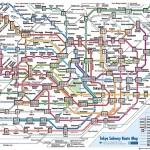 A couple quick observations about Tokyo and its denizens to this wide eyed naïve traveler. First, this is a Big City! Seems much bigger and denser than New York, and I’m not sure why. Could be the city’s organization (addresses are just as often out of order as they are sequential, streets just go all over the place, no grid like SF), could be the sheer volume of humanity and interactions, or it could be that all the signs are obviously in Japanese which floods my cognition like…uh…like (don’t go there, too insensitive…) like being in the middle of the grand finale of a July 4 fireworks display. (Phew). In any case, it’s overwhelming. In a Good Way! I’m like a Kansas farmboy going to the city for the first time. Mouth agape. Smiling at the newness and pure stimuli overload.
A couple quick observations about Tokyo and its denizens to this wide eyed naïve traveler. First, this is a Big City! Seems much bigger and denser than New York, and I’m not sure why. Could be the city’s organization (addresses are just as often out of order as they are sequential, streets just go all over the place, no grid like SF), could be the sheer volume of humanity and interactions, or it could be that all the signs are obviously in Japanese which floods my cognition like…uh…like (don’t go there, too insensitive…) like being in the middle of the grand finale of a July 4 fireworks display. (Phew). In any case, it’s overwhelming. In a Good Way! I’m like a Kansas farmboy going to the city for the first time. Mouth agape. Smiling at the newness and pure stimuli overload.
Second quick observation, aside from “normal” clothing attire, there seem to be three modes of dress that are different for me. First, for the “salary man”, the one who works in offices, there is the standard white shirt / dark grey slacks look. You see this effect especially on the train platforms, just hundreds of similarly dressed men. What’s fascinating is that they are in the middle of “Cool Biz” days, started when the Fukushima nuclear plant went down, and electricity supply (i.e., A/C, was suspect). At some point in the summer, everyone gets the signal that they can wear short sleeve dress shirts and no tie or suit. Until sometime in the fall when they go back to suits and ties. Not sure how they get this signal, but evidently they all do and one one day, everyone is in short sleeve shirts and no tie. Since it’s been 90 degrees and 80% humidity, make sense to me.
The second mode of dress is what I can best call “adventurous”. Mostly by the youth – bright and cartoonish or, less often, dark and brooding. (and remember, this is in 90 degree sweltering weather)
However, there is a third mode on that just befuddles me – Lolita Street Fashion. Women of ALL ages are wearing clothes that a young girl might put on a doll. I don’t think it’s goth, it seems like they just want to look like dolls. Here are some pictures ….you tell me.
I tried to take a few pictures of women on the street but they declined. Which was wise, I suppose. So these pictures are what I found that look pretty much like what I saw. Curious.
All in all, Tokyo to this wide eyed innocent jet lagged traveler, seems like a very thriving, affluent and happy place. Even more so than San Francisco – no homeless people or panhandlers, streets uniformly clean and non smelly. And quirky in their own way (see above “Lolita”).
Tomorrow….I travel to Hiroshima.

East Asia

East Asia

East Asia

East Asia

East Asia

East Asia

East Asia

East Asia

East Asia

East Asia

East Asia
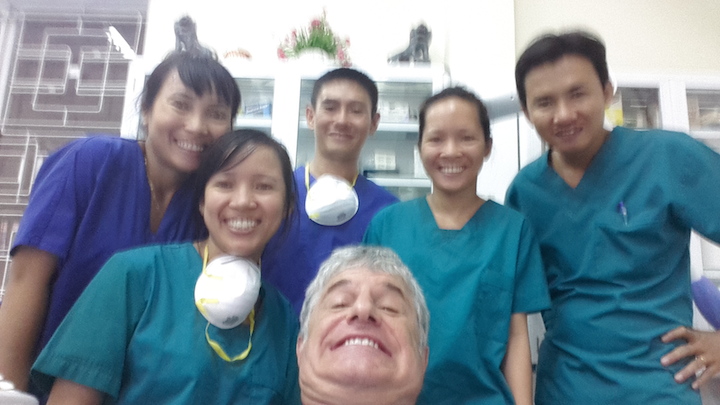
East Asia
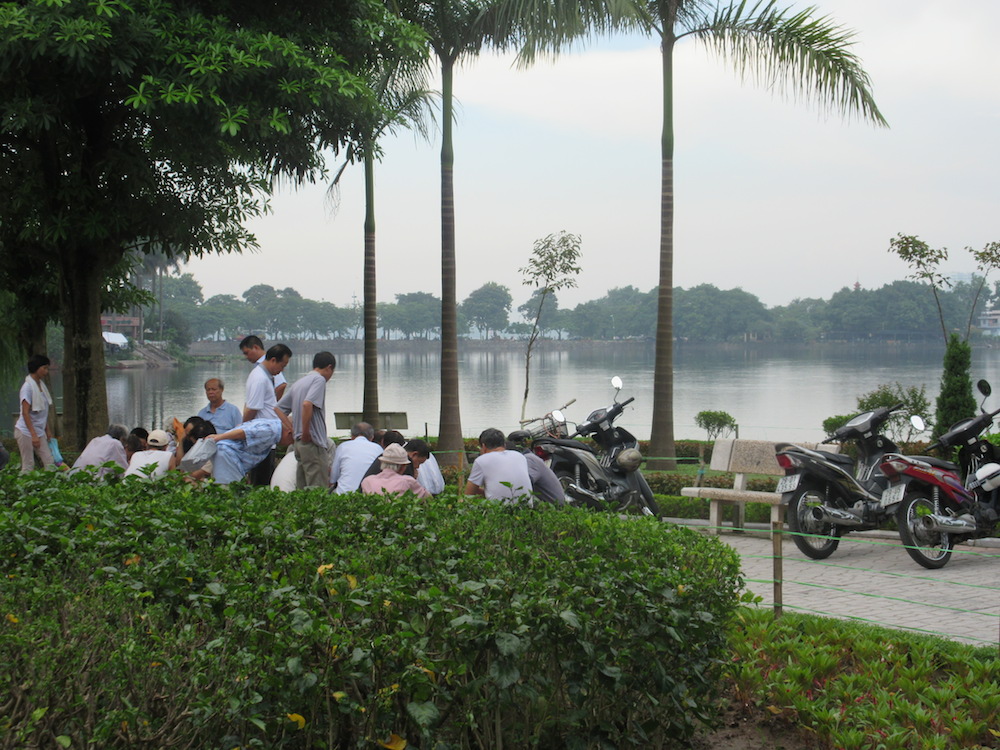
East Asia
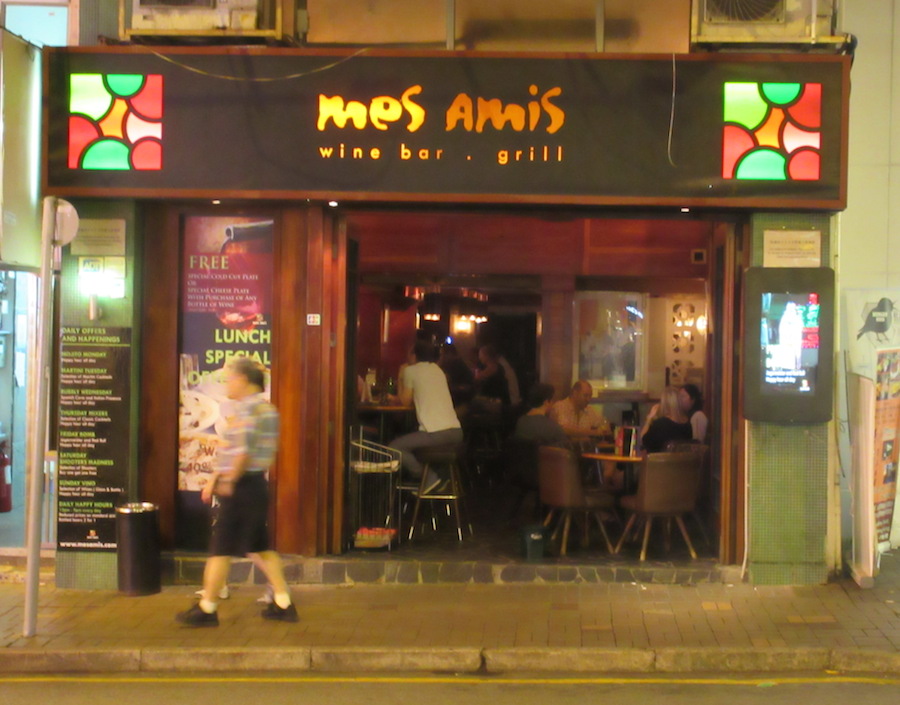
East Asia
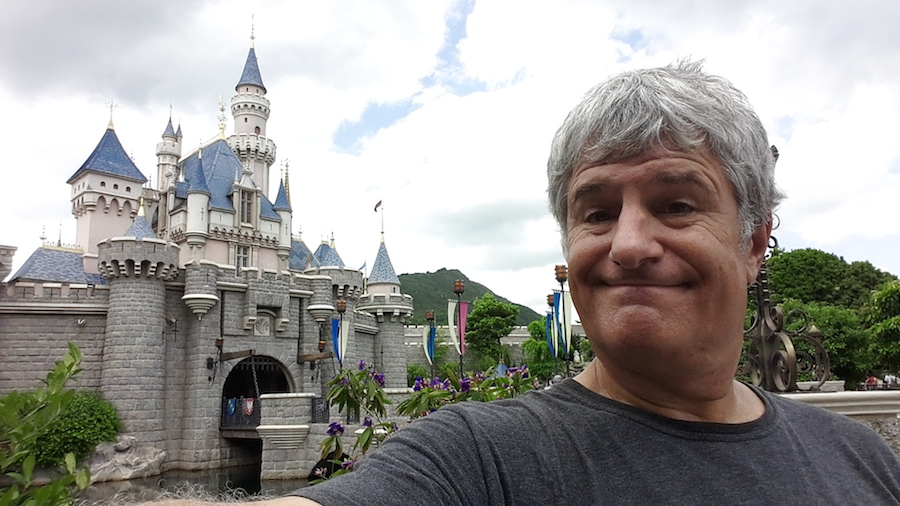
East Asia
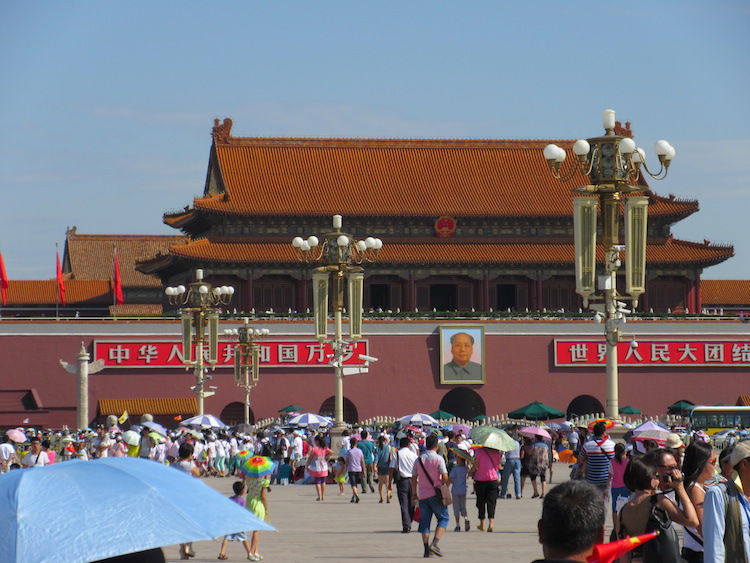
East Asia
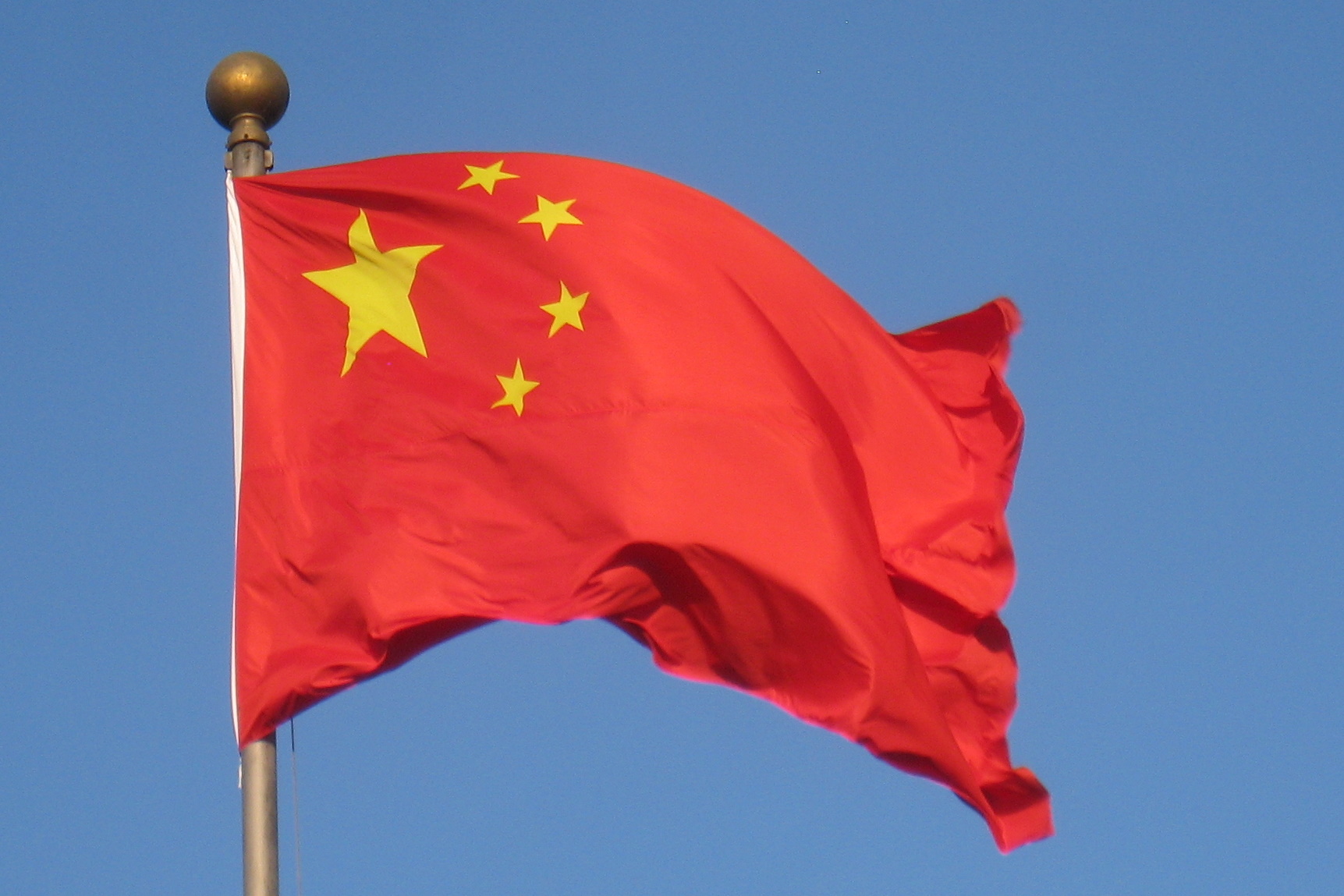
East Asia
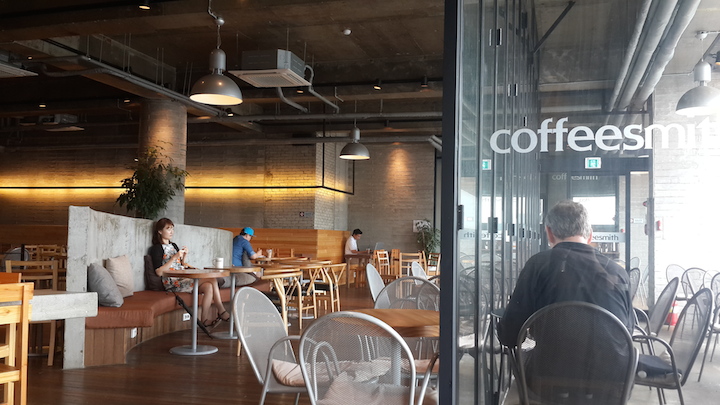
East Asia
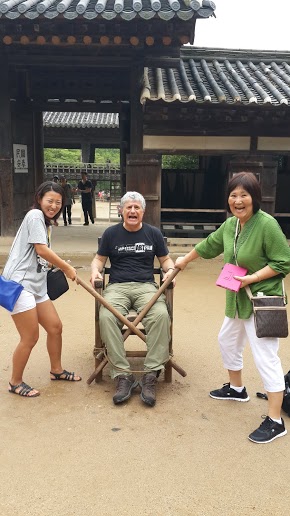
East Asia
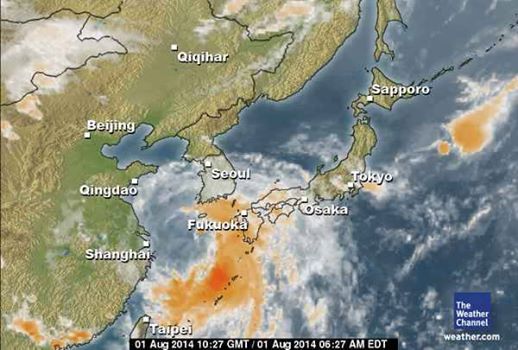
East Asia
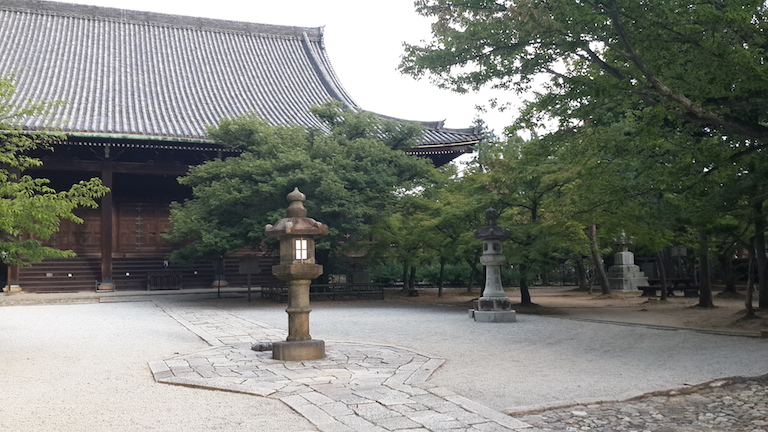
East Asia
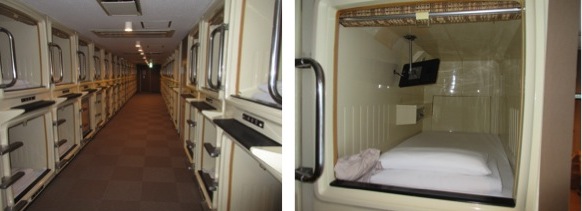
East Asia
East Asia
